0 Introduction
Energy is the driving force for automation, advancement,and economic development.Energy is one of the fundamental inputs for advancement as well as economic and social development.Energy consumption is increasing rapidly owing to population growth and economic activities.A significant supply of energy comes from fossil fuels that have limited resources and are depleting rapidly.In addition,fuels damage the environment.To highlight the depleting issue and growing concerns about the environmental impacts alternative renewable energy resources are one of the potential solutions [1].Solar energy is a highly potential renewable energy resource.It is environmentally friendly,ecologically benign, requires low maintenance, and is simple to construct [2-4].
In December 2015, the COP21 United Nations ClimateChange Conference highlighted the increasing importance of solar energy.In this conference, 195 nations signed a worldwide climate agreement aimed at, among other things,decreasing global temperatures by 2 °C [5].In addition,the climate action tracker stated that the world should cut 144 Gt of emissions by 2025 to maintain global warming at 1.5 °C [5-7].The tracker tracks the 32 highest polluters accounting for 80% of the total emissions.The Singaporebased Renewable Energy Corporation estimated that an additional 4800 GW of solar power would be required by 2025 to achieve this worldwide target [5, 8].The Fraunhofer Institute for solar energy systems research estimates that solar energy would satisfy 40% of the world’s electricity demands by 2025 [8].Academics in the field of solar systems have been motivated by the important recent global achievements to address the domain’s basic concerns, one of which is the energy conversion efficiency of PV systems.The highest efficiency of silicon crystalline cells and modules are 26.3% and 24%, respectively [9].A control approach for obtaining Maximum Power Point (MPP) is used to extract maximum efficiency from the Si material’s inherent limited efficiency, and so plays a critical part in the operation of a PV system [9, 10].
The two most prevalent types of classical approaches for maximum power point tracking (MPPT) include incremental conductance (IC) and perturb and observe (P&O) [11, 12].These methods are commonly employed because of their convenience of application, cost-effectiveness, and simplicity.However, these have unique sets of disadvantages.P&O oscillates around MPP when a PV system achieves MPPT owing to fluctuations in the operational point [13, 14].This is owing to the employment of a fixed perturbation, which results in a loss of produced energy.Furthermore, because of slower convergence, the P&O approach is incapable of following MPP in rapidly changing environments.This is because it considers fluctuations in current relative to voltage and helps with fast irradiation changes.The IC MPPT method has a higher computational complexity than P&O.The uncertainty in selecting the step-size and the ensuing oscillations (as with P&O) is a disadvantage of this approach[2-4].The MPP computed using approximation functions of the short circuit voltage and open circuit current in other basic techniques such as short circuit and fractional open voltage procedures [4, 15].
PV systems are challenging from the standpoint of control engineering because of their nonlinear properties.Variable climatic circumstances have an impact on PV systems.This necessitates the use of a simple and adaptive controller that can change with the environment [16].Consequently, a simple and reliable controller is required to track the MPP in real time and accurately under varied operating conditions.A comprehensive review of the recent research on MPPT methods deployed for partial shade conditions is presented in [17].Conventional MPPTs fail to provide these criteria of robust and adaptive control under rapidly changing environmental circumstances [4].Artificial neural network (ANN)-based methods [18];fuzzy logic [13]; and metaheuristics such as Cuckoo Search (CS), Grey Wolf Optimizer (GWO), and particle swarm optimization (PSO) are presented in [16].However,compared with conventional procedures, the computational complexity-based limitations of these technologies restrict their practical application.Furthermore, ANN-based MPPT methods require a considerable quantity of data for appropriate training (various irradiations, temperatures, and partial shade situations).This renders these viable only for large PV panels [18].Furthermore, metaheuristics-based techniques display severe transient behavior (duty cycle or reference voltage) during the search for the optimal value.Under rapidly shifting environmental circumstances, this results in delayed convergence and may cause premature convergence [4].Fuzzy logic control (FLC) has a relatively low processing complexity and is equivalent to ANN in terms of efficiency.However, FLC design necessitates a thorough understanding of PV functioning.Furthermore,the FLC rule table can result in additional computation if it is not optimized appropriately.Various combinations of intelligent approaches were investigated to counteract these disadvantages.The FLC’s membership functions and rules were optimized using PSO [19].To overcome the static fuzzy rule table, [20]proposed an FLC combined with a Hopfield ANN.Bat algorithm-based MPPT [21].Grey Wolf Optimizerbased MPPT [22, 23].Machine learning-based MPPT [24].
For MPPT, artificial intelligence techniques are widely used and combined with other approaches.However,the practical implementation of complex MPPT systems is limited owing to the decreasing solar cell prices.Conventional MPPT techniques such as IC, P&O, and proportional integral derivative (PID) should be improved by researchers [4, 5].Yang et al.[25]recommended a method to improve the memetic salp swarm algorithm to achieve maximum energy point tracking in different atmospheric conditions.Yang et al.[26]introduced a new algorithm for MPPT through the existing dynamic leader collective intelligence for PV systems under PSC.The results demonstrate the superiority of their algorithms over several existing recent algorithms.
This study presents a new hybrid approach based on two optimization algorithms: GWO and CS with the IC algorithm.This is to enhance the performance and efficiency of PVsystems under non-uniform conditions.The contributions of this study are that it addresses a variable step-size and early step decision for the standard P&O algorithm, presents a modified MPPT technique based on the hybrid GWOCS MPPT to include the capability of MPPTs to account for slow and fast variations in solar irradiation, and achieves the GWO-reduced MPPT’s processing time.
1 System Configuration
The key modules of the proposed PV system include PV panels, a DC/DC converter, and the MPPT algorithm (see Fig.1).A relevant mathematical model extraction and the problem formulation of the proposed MPPT are included in this section.Initially, the entire dynamic model of the PV module in use and its parameters are provided.An introduction to the MPPT controller, which is employed in this study and problem formulation, follows the description of the used DC/DC converter are presented.The PV system is composed of four strings.Each string includes three panels as shown in Fig.1.The total output power of the PV system is estimated to be 1800 W, and each PV module has 150 W.Table 1 shows the specification parameters of the PV modules deployed.
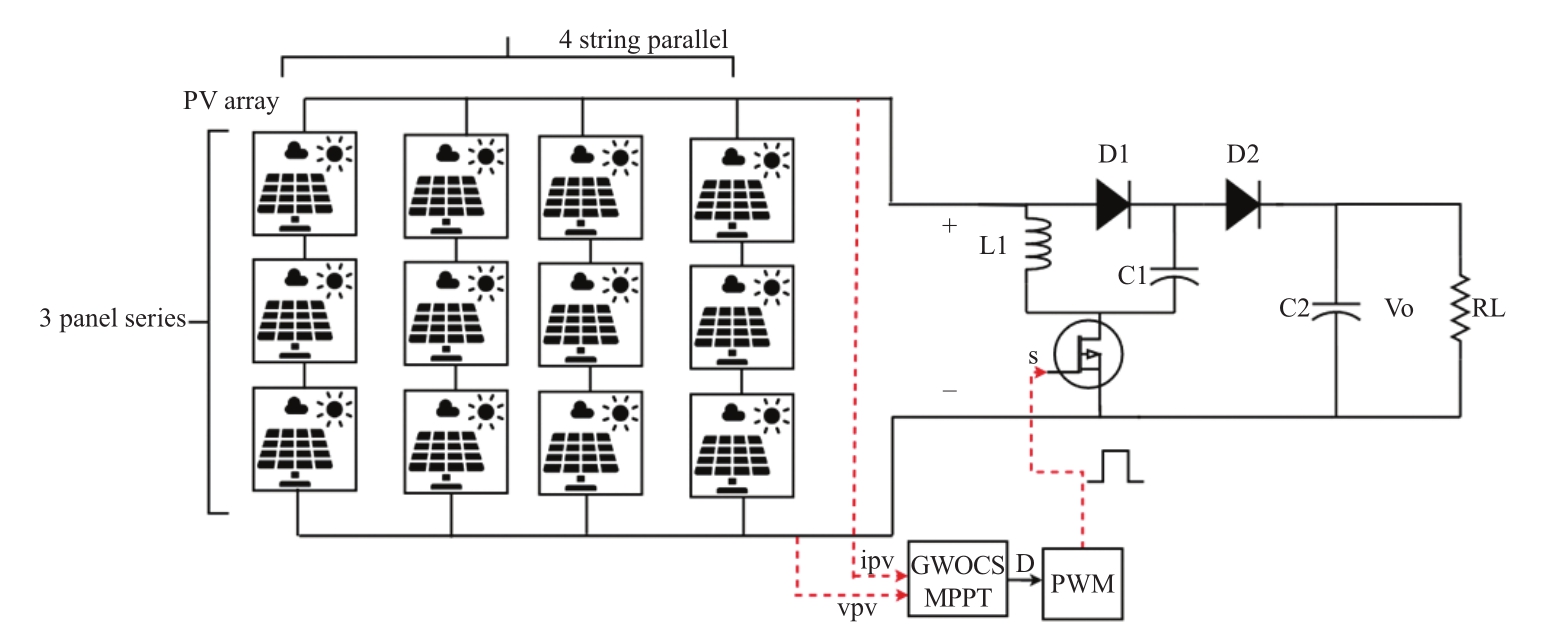
Fig.1 The proposed system configuration
Table 1 Specification parameters of BS-SP150/12Vtype [27]
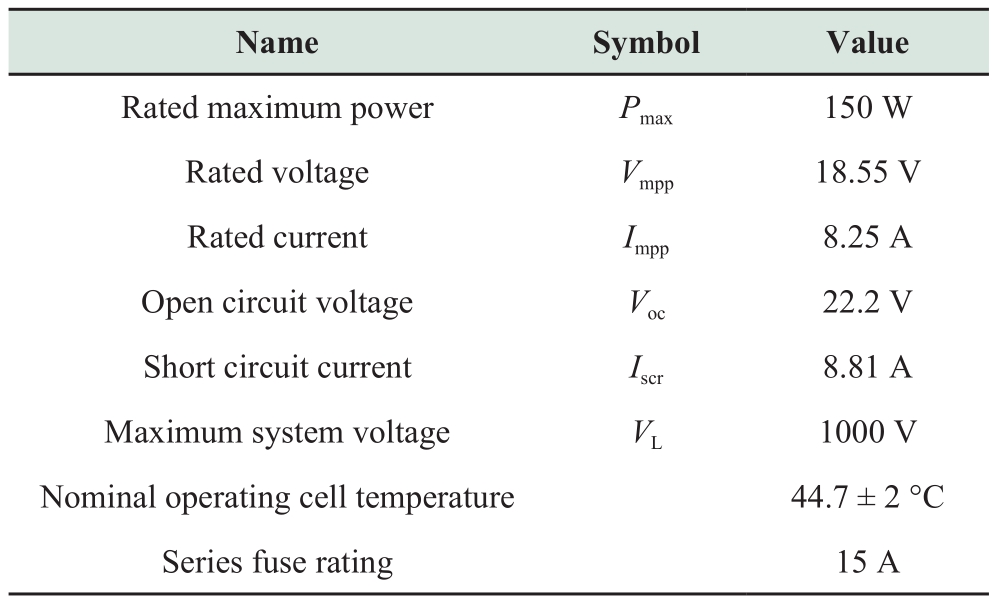
1.1 Mathematical Modeling of PV Cells
The recombination losses in the depletion area are omitted in a single diode model.A more accurate model is obtained by accounting for the recombination losses.Double diodes are used to reflect PV cell physics (see Fig.2).A commercial PV module comprises many identical cells(mono or poly-crystalline).Cells can be linked in parallel or series depending on the requirements, to increase the current or to provide additional voltage.The common mathematical formulation of the resultant current for a double diodebased PV module may be obtained by expanding a PV cell model by adding strings of parallel-and series-connected cells.Equations (1) – (6) present the common mathematical expression for the resultant current for a double diode-based PV module [28].

Fig.2 Equivalent circuit of the PV cell’s double-diode model [28]
The continues describes the PV module’s output current in a double diode can be expressed as
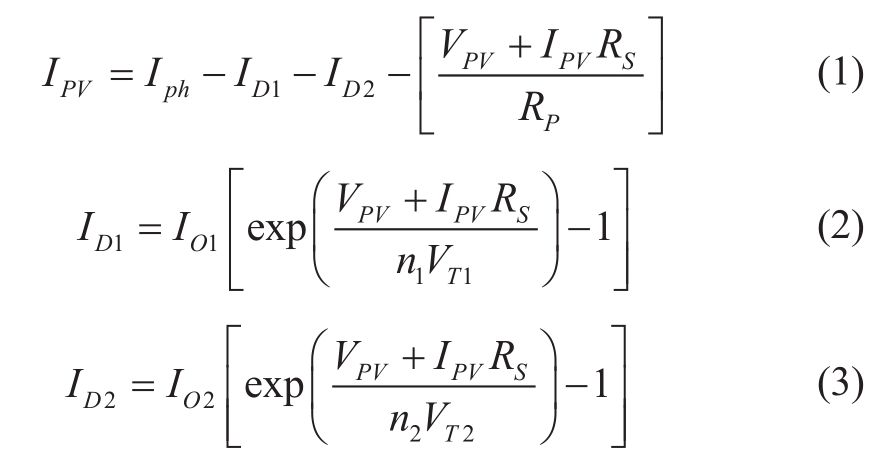
where Iph is the photogenerated current.RS and RP represent the series and parallel resistances, respectively.IO1, IO2 are the saturation currents of the double diodes.VT is the thermal voltage, and n1, n2 are the idealist factors.The sevenparameters, IO2, Iph, n1, n2, RP, and RS should be measured.
Iterative methods such as the Newton method have been used to evaluate the saturation current values for the diode model (IO1 and IO2) [28].These methods increase the computation time owing to the assumption of suitable initial conditions.In general, it is higher by three–seven orders of magnitude.To simplify this, the saturation currents of the two diodes can be measured as [28]
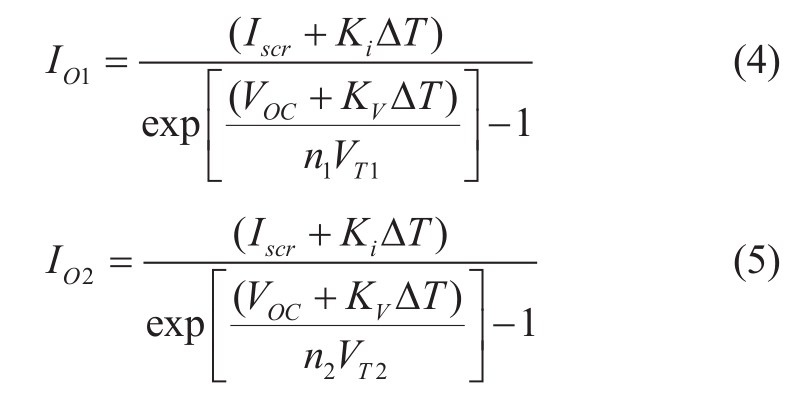
where VOC is the open-circuit voltage and Iscr is the shortcircuit current.K is the Boltzmann constant.
1.2 Luo DC–DC converter
One of the main elements that contribute to the investigation of the maximum power under shading conditions is the DC–DC converter.The basic step-up converter is called boost converter.It has certain advantages such as simple structure, operation, and implementation.However, it has limitations such as a low gain ratio,reverse recovery diode under the higher value of duty cycle (D > 0.7), and high voltage stress on active switch[29-31].In this study, the super positive Luo converter is used rather than a simple boost converter.Luo converters are DC-DC converters that operate in a similar manner as boost converters.Compared with a boost converter, a Luo converter has a high gain ratio and low output ripple of voltage and current.In addition, it assists the MPPT algorithm in rapidly attaining the maximum power.
The basic concept of a super positive Luo converter depends on charging the passive elements in parallel during the ON mode and discharging in series during the OFF mode (see Fig.3).The gain ratio can be expressed as follows based on this principle [31]:
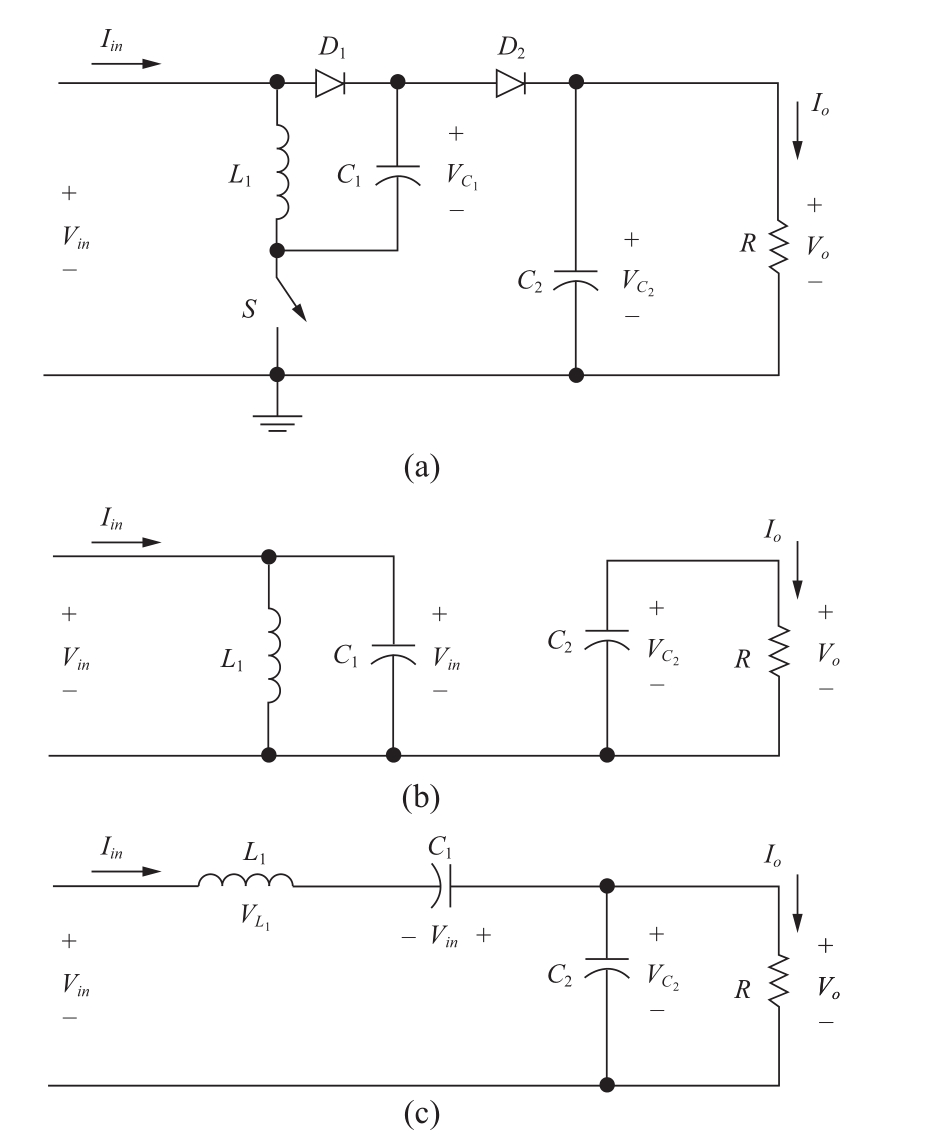
Fig.3 Equivalent circuit of positive super lift Luo converter,(a) elementary circuit (b) ON switch, (c) OFF switch
Omitting the losses, the input current can be determined as
The design of passive elements is essential for operating the DC-DC converter in a perfect mode with an MPPT algorithm.The output capacitor is driven based on the variation ripple in output voltage.It can be expressed as
The pumping inductor can be designed during the ON mode as
Finally, the lift capacitor can be designed as follows depending on the relationship between the voltage and current of the principle operation capacitor and the working principle of the super positive Luo converter:
2 PID Controller
The PID controller is used to control several things such as temperature, pressure, velocity, and flow.This controller uses the available information that come through feedback.Moreover, a specific point is generally set.The controller constantly observes the difference between the output and specific point.The controller directs the output value using proportional, integral, and differential controller parameters.The error value reduces through this process.The PID controller continues to automatically correct the error that results from the difference between the output and set point [32].
2.1 Perturbation and Observation (P&O) MPPT
The perturbation control and monitoring approaches are popular because of their simple implementationstructure and because these only require voltage and current sensors [3].When the MPP is attained, the P&O algorithm continues to alternate around it without stopping using the previous values of the power sample to increase or decrease the reference voltage.This method is used when a marginal increase in the PV operating voltage is disturbed and the variation in power (P) is positive.It should continue moving in the same direction as illustrated in Fig.4, because it travels in the direction of the MPP.The operating point shifts away from the MPP if the variation in power P is negative.The signal should be altered to address the disturbance.
The mathematic equation of the P&O strategy is driven according to the equations below:

To achieve the maximum power, assume
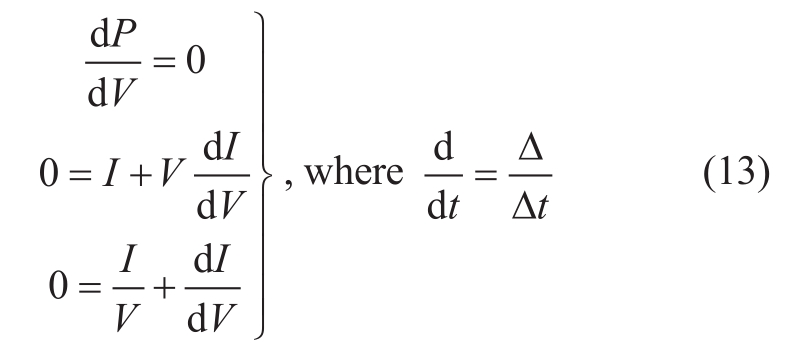
The simulation process of the above equations is depicted in Fig.4.
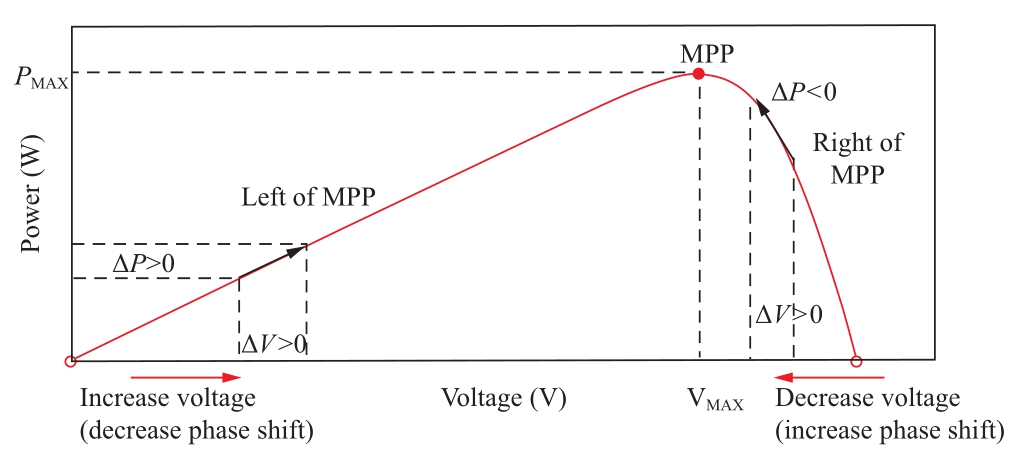
Fig.4 P-V graph for P&O control method
Figure 5 shows a flowchart of the P&O algorithm.It depends on the perturbed operating voltage compared with the prior one.The PV array’s voltage is enhanced if the power difference (∆P) and voltage difference are positive.The PV array’s voltage would increase if both voltage difference and ∆P are negative, and decrease otherwise.In this manner, the next cycle is repeated until the MPP is attained.
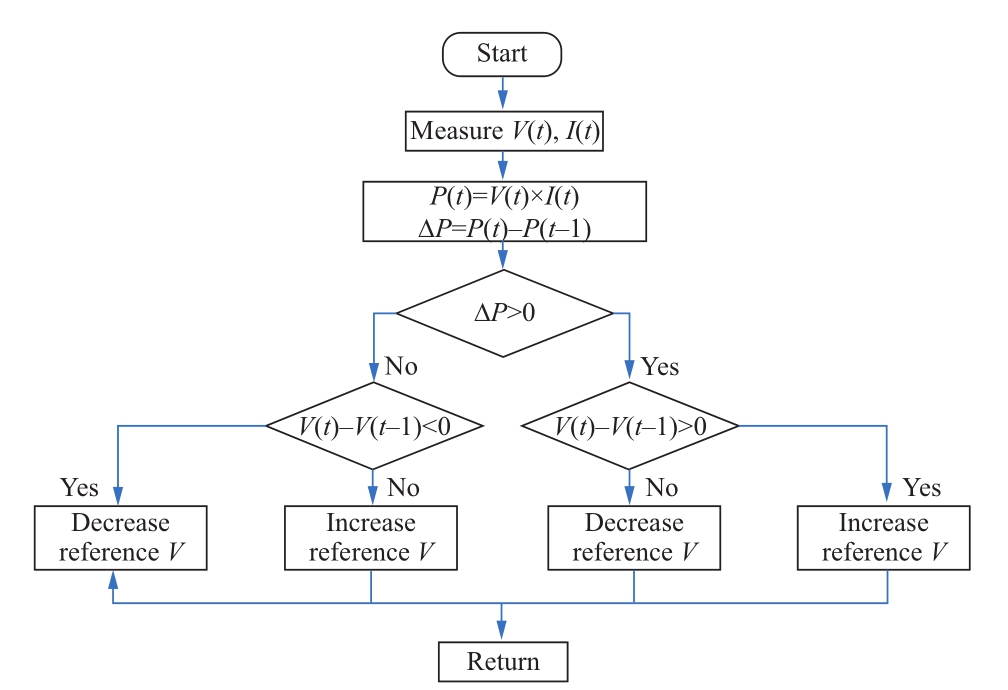
Fig.5 Flowchart of the control method of P&O
2.2 MPPT Controller
The controller is designed based on the P&O algorithm equation![]() as shown in Fig.6.The figure shows the simulation developed in MATLAB.This equation considers the condition for achieving MPPT through the concept of the P&O algorithm work.
as shown in Fig.6.The figure shows the simulation developed in MATLAB.This equation considers the condition for achieving MPPT through the concept of the P&O algorithm work.

Fig.6 Matlab simulation of MPPT controller
In the figure,
where Vi represents the current voltage and Vi-1 represents the previous voltage.
where Pi denotes the current power (Pi = Vi × Ii), Ii represents the current, Pi-1 indicates the previous power(Pi-1 = Vi-1 × Ii-1), and Ii-1 depicts the previous current.
Note that in the figure below, Pb is the previous power,and Pn is the current power.Zero is set as a set point, thenthe result of (dP/dV) compared with the set point, if the result equal zero that mean MPPT achieved while any other result mean there is error, this error will be the input to the Fitness function.The PID controller would resolve the error.
3 Cuckoo Search
One of the most effective swarm optimization methods is the CS algorithm.It was launched for the first time in 2009 [33].The parasitic characteristic of the Cuckoo’s reproductive mechanism inspired the algorithm.Rather than constructing its nest, the bird deposits its eggs in the nests of other birds.It utilizes a strategy to select a good host nest.Herein, it flies randomly from one nest to the next to identify the best one.The nest with the highest chance of hatching eggs successfully is defined as the best nest.Cuckoos may throw the host bird’s eggs out of the nest to increase the chances of their eggs hatching successfully.To prevent detection, certain Cuckoo species may alter the shape of their eggs to replicate those of the host birds.If the host bird detects the Cuckoo’s deception, it may abandon the nest or throw the Cuckoo’s eggsout.The CS algorithm is based on the Cuckoos’seeking activity.CS may make a lengthy leap during its search by employing random steps based on Lévy flight characteristics.This improves the global search and may minimize the convergence time.Owing to its long convergence time and large oscillations in steady-state circumstances, the original CS (OCS) method is designed to address multi-variable problems involving multiple objectives.This makes it unsuitable for MPPT of PV systems.The following part introduces the improved CS(ICS) method, which solves this problem.Meanwhile,the OCS employs the Lévy flight to update the values of multiple searching agents that randomly initialize with initial values within the bounds of the searching region.

where t is the generation number; k is the searching agent order in the swarm; and u, v are the matrices having uniform distribution.u, v are calculated by (18):
The variance of u, v can be determined as

4 Grey Wolf Optimizer
The approach was first published in 2014 [34].The natural behavior of grey wolves in pursuing prey inspired this optimization approach.Grey wolves dwell in packs of five–ten individuals [35].There are four tiers of leadership in this organization.The leaders are defined as alpha (α),whereas the subleaders are defined as beta (β), delta (δ),and omega (ω) according to their positions in the wolf dominance pyramid [5].The pyramid grows from top to bottom [34].The following is a mathematical depiction of the hunting methods of wolves [34]:

where t is the current generation, d(t) is a vector indicating the grey wolf’s position, and dp is a vector representing the prey’s position.The two coefficient vectors (A and C)are utilized to ensure a balance between exploration and exploitation.Their values are determined by Equations (22),(23), and (24):

where A decreases linearly from two to zero.r1, r2 are random vectors with values ranging from zero to one.MaxIter represents the maximum iterations used in GWO(five iterations are considered).The prey is surrounded by the grey wolves.The members of the pack should obey the instructions of the leader (alpha wolf) first, then those of the beta wolves, and finally those of the delta wolves.The following equations can be used to depict the grey wolves’leadership process mathematically [16, 34, 35]:
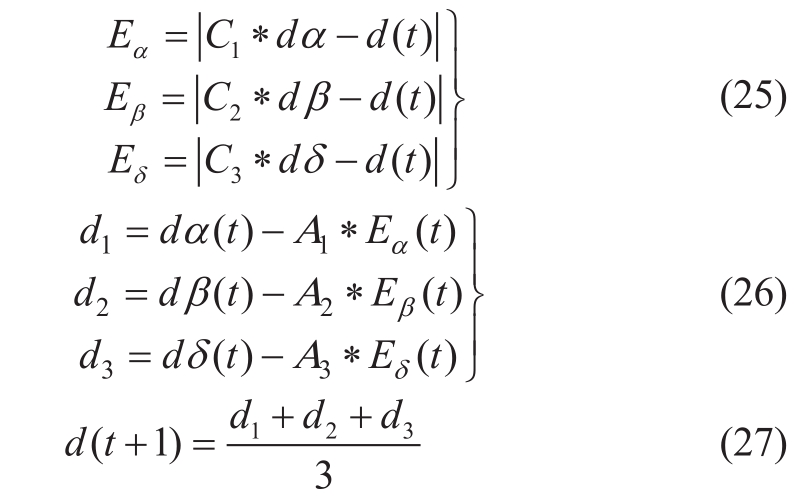
The coefficient |A| ≤ 1 when the wolves tend to exploit(converge to the prey), and |A| ≥1 when the wolves tend to explore.
5 Proposed MPPT Approach
The hybridization of the GWO and CS algorithms in the proposed approach would increase the accuracy, speed, andother performance measures.The CS algorithm based on the discovery factor as the nests that are exposed replaced.It is used for global exploration optimization.However, it reacts ineffectively in local exploration.The GWO algorithm is considered successful in the local exploitation aspect.However, it displays its drawback in the global exploration aspect.As a result, when the two algorithms are combined,the Cuckoo algorithm improved the grey wolf algorithm in terms of enhancing its ability to global exploration area.CS is used to update the locations of the alpha wolf (α), beta wolf (β), and delta wolf (δ), whereas the GWO algorithm handles the process of identifying the best coefficients for MPP tracking.
The proposed approach starts by generating an initial population of n random search space agents for the grey wolf.Each agent carries encoded random PID coefficient values at the initialization phase.The evaluation function and its fitness are calculated for each agent.Accordingly,the best agents with the highest fitness values are selected.Thereafter, the positions (α, δ, and δ) of the current selected agents are updated using the CS algorithm.The algorithm receives the fittest agents from GWO and starts by selecting a random Cuckoo and nest.The CS encapsulates an opposition-based learning technique.It is applied to strengthen the capability of global exploration by comparing the fitness of the candidate and opposite candidate, and select the best fitness value.This enhances the exploration.Further, the evaluation function and fitness values are calculated for the updated search agent positions.Finally,the search agents are updated based on the fittest agents,and the entire process continues until the maximum number of iterations is attained.The algorithm stops and returns the best search agent coefficient values when it satisfies the terminating condition.
The GWOCS approach is employed to tune the PID controller for investigating the fast tracking of maximum power under non-uniform conditions.Figure 7 shows a schematic that explains how the GWO and the proposed GWOCS function in MPPT in a PV system.The fitness that is used to tune the parameters of the PID controller is the integral time absolute error (ITAE).The ITAE equation is expressed as
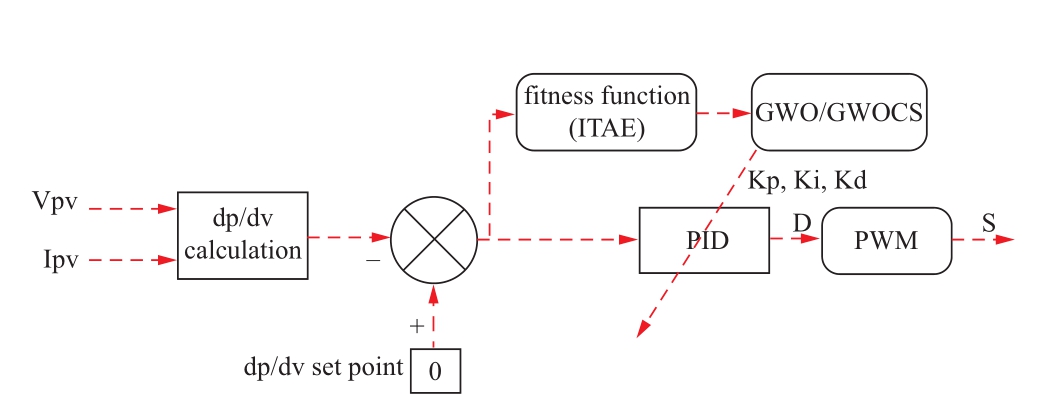
Fig.7 GWO/GWOCS-based MPPT for PV systems

where jmin is the minimum fitness and t is the simulation error.The optimal parameters of PID are based on the GWO and GWOCS algorithms that are used in the simulation results presented in Table 2.
Table 2 Optimal PID gain coefficients, which are estimated based on GWO and GWOCS
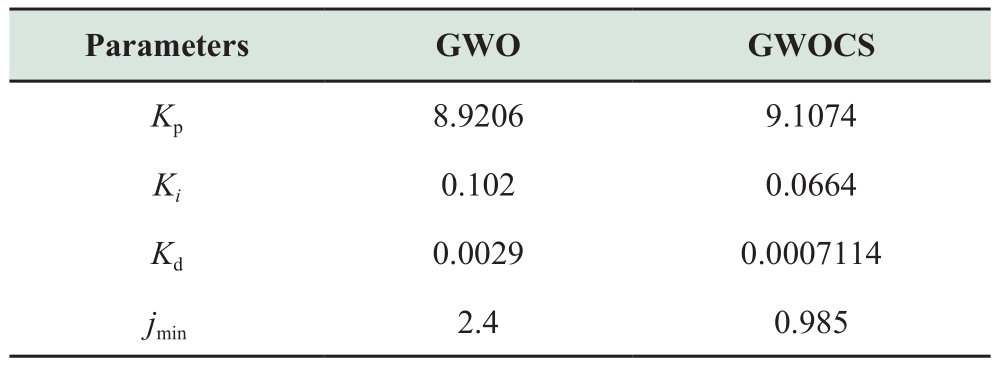
The MPPT controller is necessary to alter the duty cycle of a DC-DC converter to achieve effective MPPT.dp/dv is considered as a reference point for MPPT control as indicated in Fig.8.The result of dP/dV is continuously compared with zero for MPP tracking.The error value is sent to the mechanism that controls the DC–DC converter.The controller generates the response represented by duty cycles to increase the generator of pulse width modulation(PWM).The converter directs the operating point in the PV toward MPP.The main advantages of the current MPPT are the fast capture of the maximum global energy under rapid changes, simple implementation, and absence of oscillation with significantly small ripples.This is achieved by selecting the P&O technique.The technique is characterized by its low cost and convenience of implementation.This makes it capable of tracking the maximum power rapidly when climatic conditions change rapidly and without noticeable fluctuation, by improving its work based on the controller (which functions based on the hybrid GWOCS algorithm).
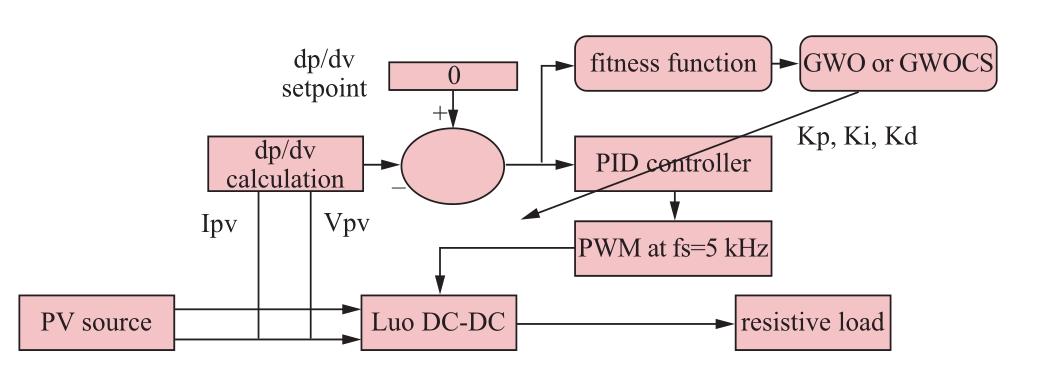
Fig.8 dP/dV feedback based MPPT control scheme
6 Results and Discussion
The hybrid system is constructed using Simulink and them.file in MATLAB (R2018a).A system validation design and simulation, Simulink for MATLAB, designing a solar panel plant, a DC-DC converter, and proposed MPPT with resistive load.
6.1 Effect Variable Temperature and Irradiation of Array PV System
The characteristics of the photovoltaic array are plotted,e.g., the I–V and P–V curves for an array under variable conditions (radiation or temperature).It is also known that the variation in the PV array current is related to that in the radiation value (which appears in the simulation results in the shape) and that the variation in the voltage of the PV array is related to that in the temperature of the PV array.Figure 9 shows the I–V, P–V curves for an array with different radiation levels.Meanwhile, Figure 10 illustrates the I–V, P–V curves for an array with different temperature levels.
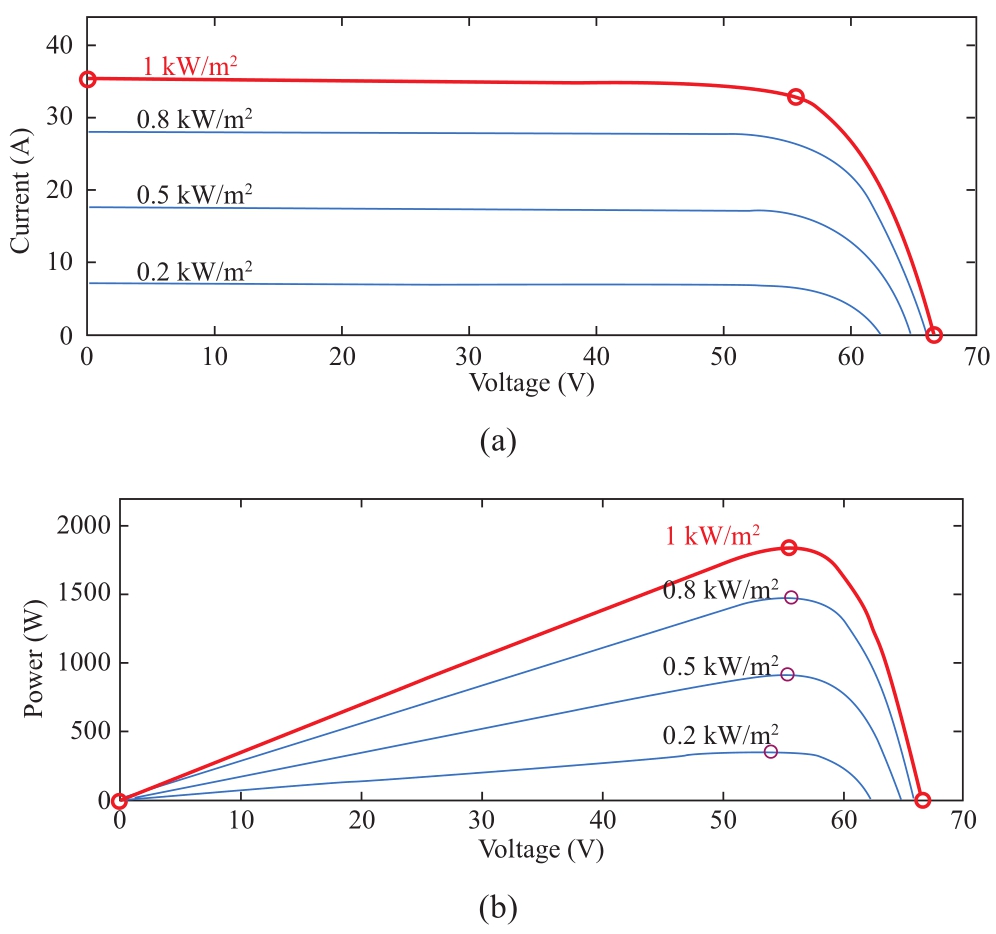
Fig.9 (a) I-V curve and (b) P-V curve at different irradiation level
6.2 Normal Operation Conditions
In this scenario, the conventional P&O algorithm and the two proposed intelligent MPPT (GWOCS-based MPPT and GWO-based MPPT) are tested under STC (Standard Test Condition, 1000 W/m2, 25 °C).The output responses of the PV system for PV current, PV voltage, and PV power are measured and discussed.This first scenario shows the tracking performance of MPP of the three approaches (conventional P&O, GWO, and the proposed GWOCS) in normal operating conditions without accounting for partial shading.
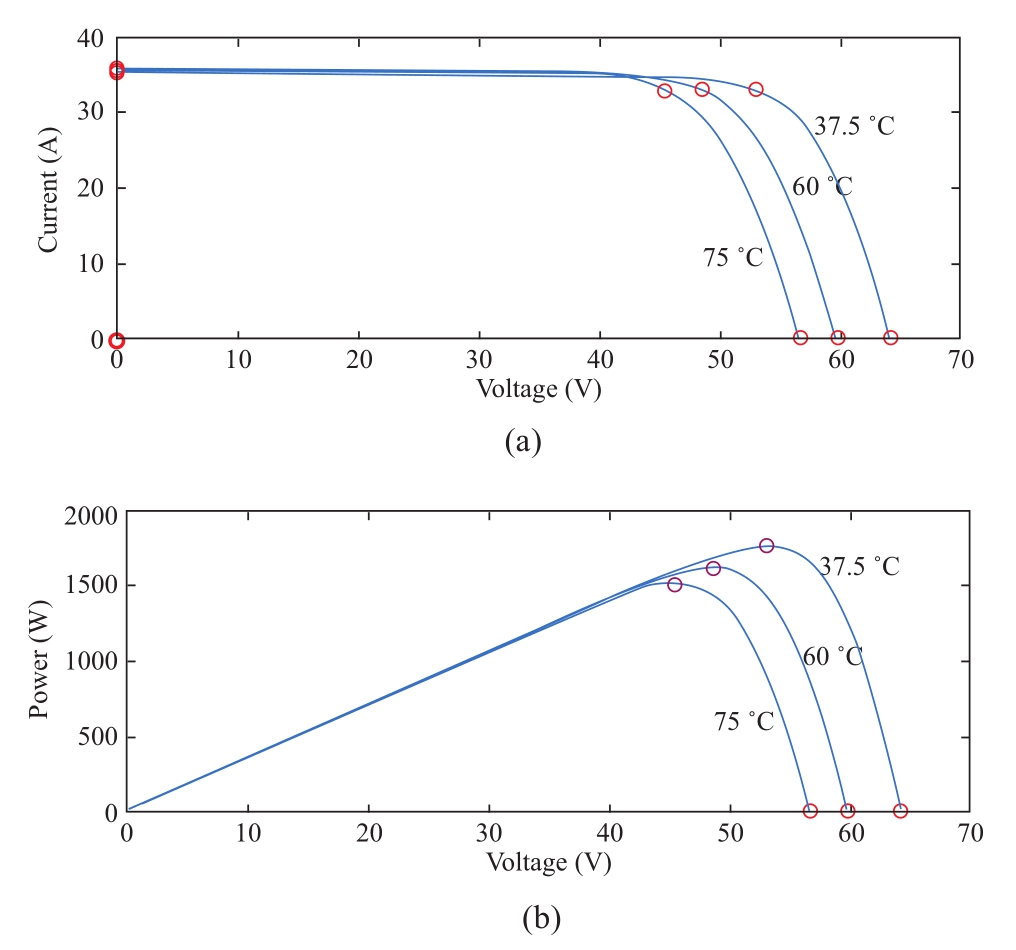
Fig.10 (a) I-V curve and (b) P-V curve at different temperature level
Figure 11 depicts the system’s output power under STC circumstances.The simulation results show that the recommended MPPT can track MPP in a short time.Meanwhile, the normal GWO algorithm is faster and has fewer power losses than the P&O approaches.
Figures 12 and 13 depict the PV array current and voltage, respectively.In this scenario, GWOCS has thebetter dynamic response of the system output voltage and current than GWO, whereas GWO has the better performance and attains the maximum power point more rapidly than P&O.However, P&O is the least effective technique owing to its significant volatility around MPP,which reduces the output power produced.This is the most typical problem with the P&O approach because it necessitates higher duty cycle levels to increase MPP tracking.Hence, the hybrid intelligent MPPT is required to increase the duty cycle step size may help them become more efficient.
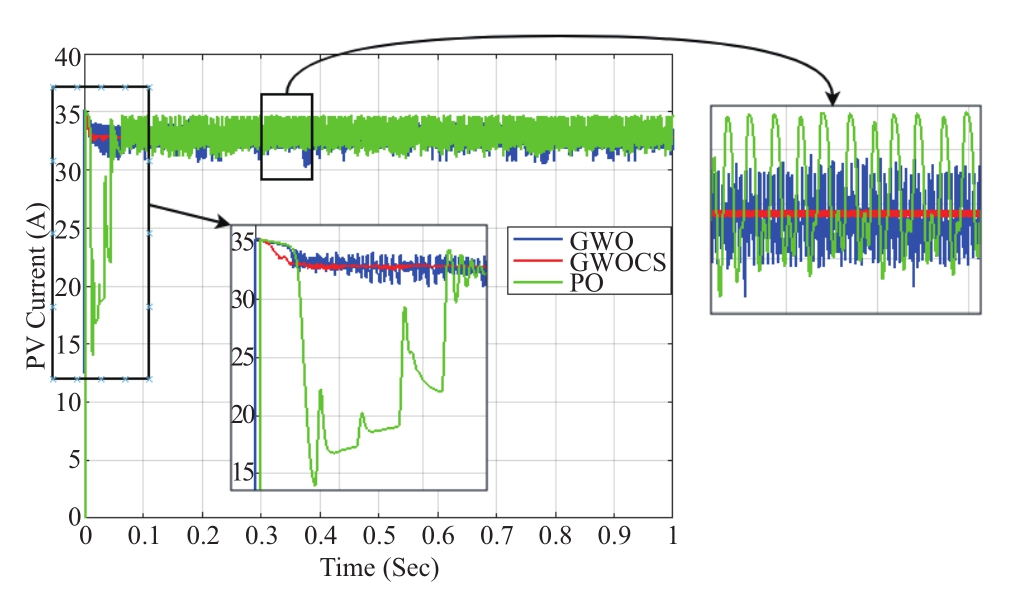
Fig.11 PV current response under STC condition
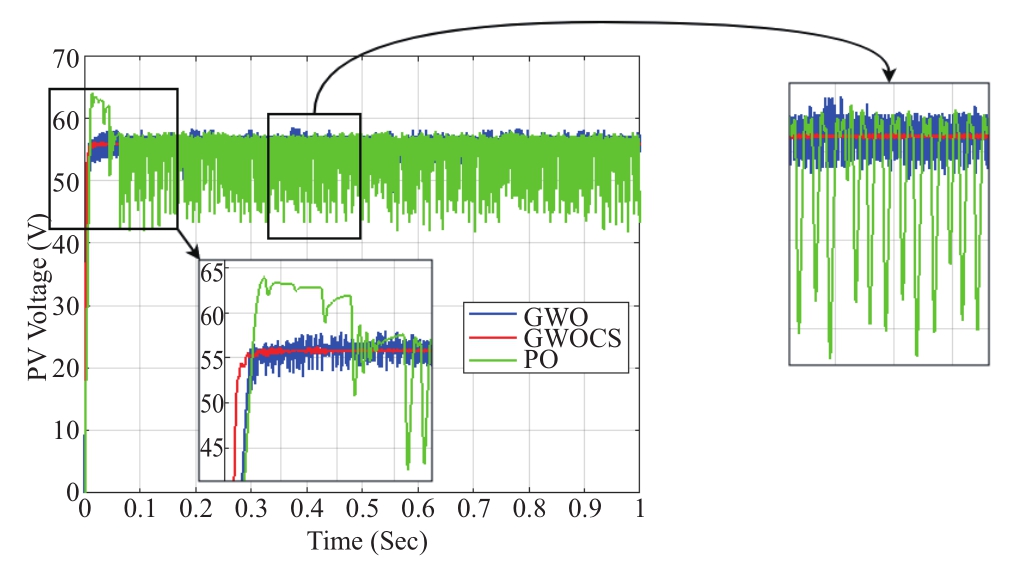
Fig.12 PV voltage response under STC condition
Finally, the P-V curve is illustrated in Fig.14.It is evident from this figure that the GWOCS-based MPPT rapidly attains the maximum power without oscillation and with negligible ripple compared with the GWO-based MPPT and conventional P&O algorithm.
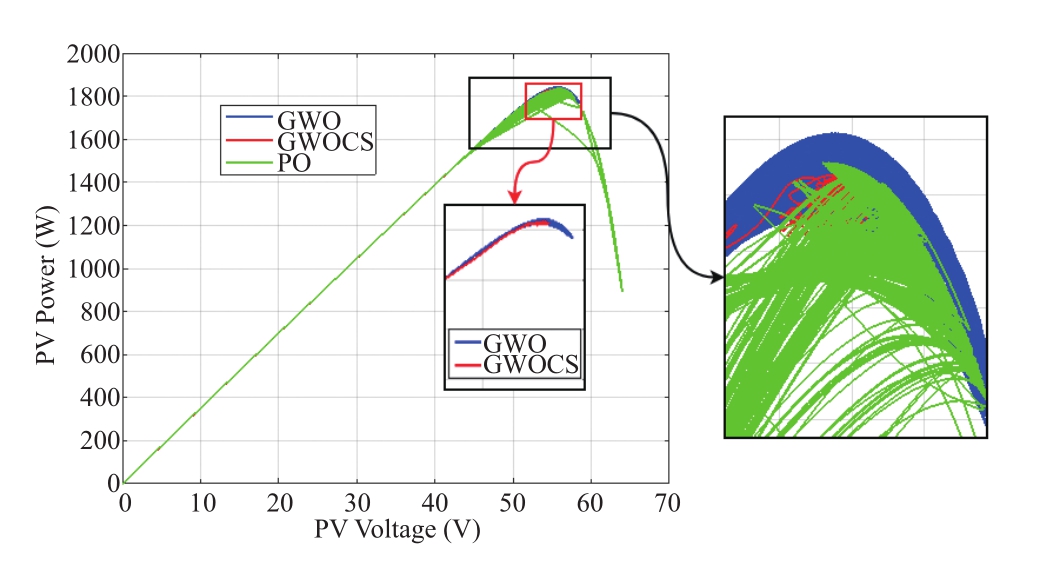
Fig.14 P-V curve under STC condition
6.3 Irradiation Variation
The second scenario shows the performance of the three MPPT approaches to address the random non-uniform irradiance at a constant temperature.This case replicates the presentation of clouds and abrupt change of obstacles in front of the solar panels and the performance measure of the approaches to operate in these partial shading situations.Although a controller’s MPPT tracking efficiency may be remarkable under static settings, it can drastically reduce under rapidly changing environmental circumstances, particularly when exposed to irradiation.Therefore, performance evaluation in the scenario of constantly changing environmental conditions is critical.This partly addresses rapidly changing environmental circumstances, which occur daily with a high frequency.In this test, the irradiance varies rapidly, whereas the temperature remains constant.
Figure 15 depicts the profile utilized for this scenario.It should be observed that this fluctuation occurs between a low irradiation level of 150 W/m2 and the highest irradiation level conceivable (1000 W/m2).Furthermore,the temperature is maintained as STC (25 °C) during the irradiation fluctuation.
The resulting MPPT responses for the PV current,voltage, and maximum power are shown in Fig.16-18.
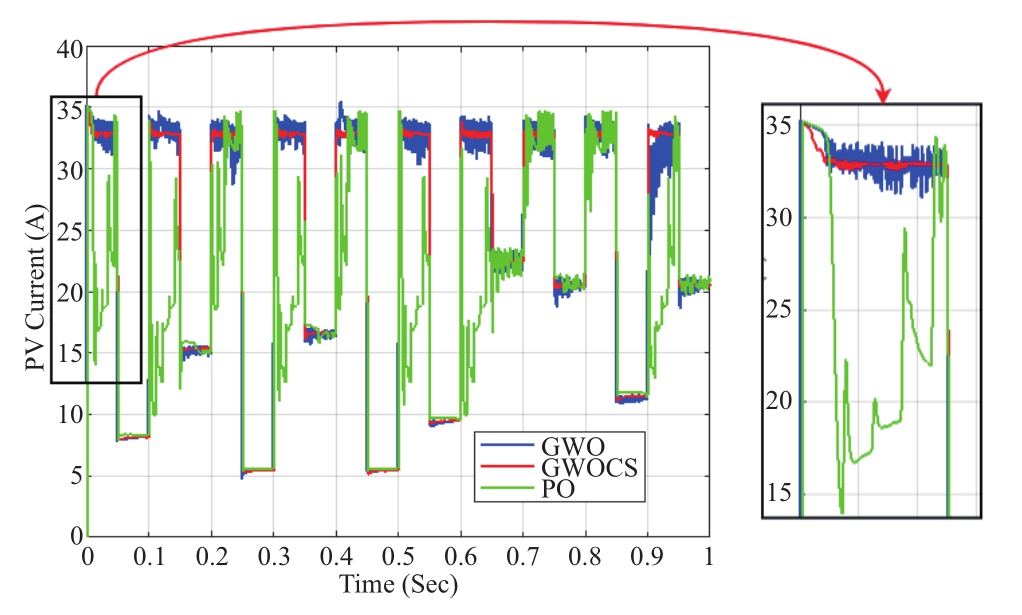
Fig.16 PV current response under non-uniform irradiance
The performance of the hybrid GWO and CS algorithm MPPT controllers is higher than that of the GWO MPPT controller and conventional P&O algorithm in terms of fast tracking to the maximum power notwithstanding rapidly variable irradiation with a significantly small period, lower ripple, with no oscillation and overshoot.
Figures 16 and 17 indicate that the proposed approachsuccessfully traces the commanded PV currents and voltages.It is evident from these figures that the proposed GWOCS-based MPPT has a lower ripple and maximum undershoot than the GWO-based MPPT controllers.Note that this increase in power is caused by a shift from a lowirradiation zone to a higher-irradiation zone after a small period.As stated earlier, most conventional and intelligent MPPT controllers fail to track success in these situations.Meanwhile, the proposed MPPT controller does not lose track and prevents the system response from deviating from the set point.
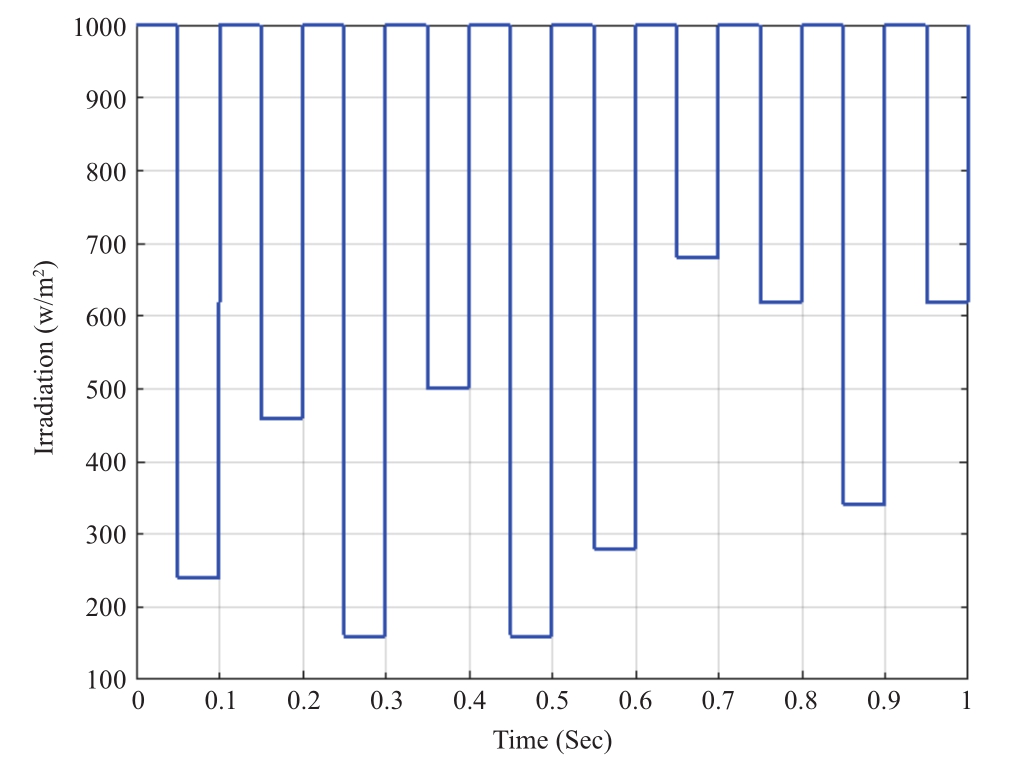
Fig.15 Non-uniform irradiance
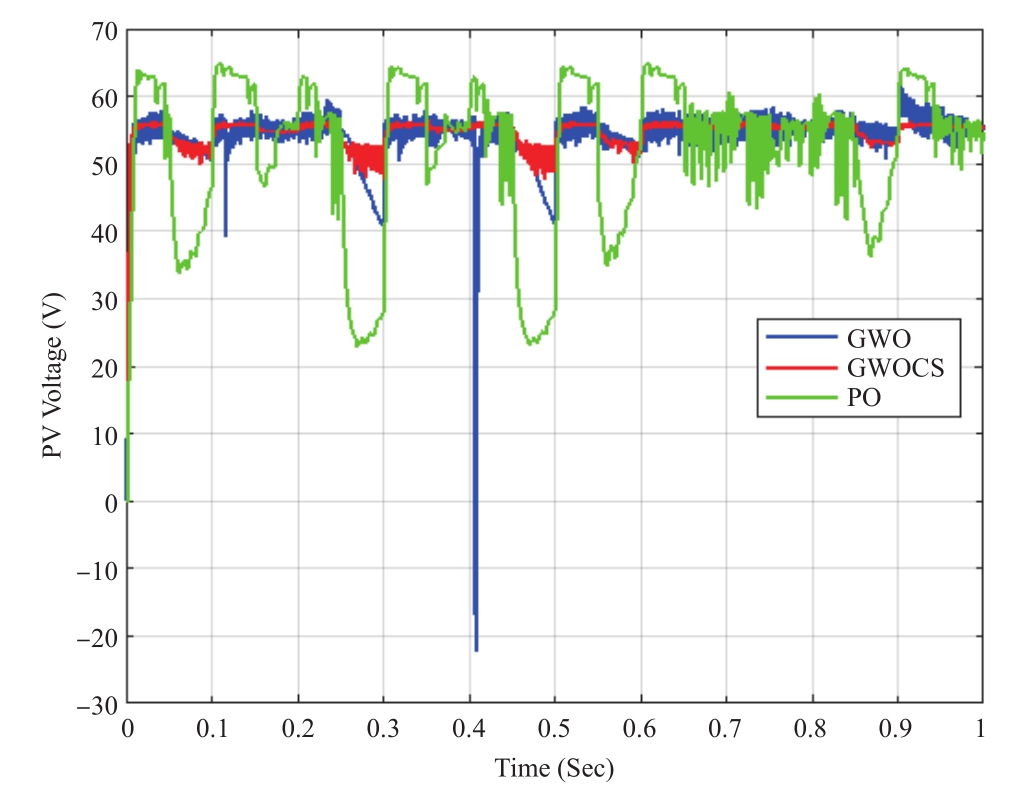
Fig.17 PV voltage response under non-uniform irradiance
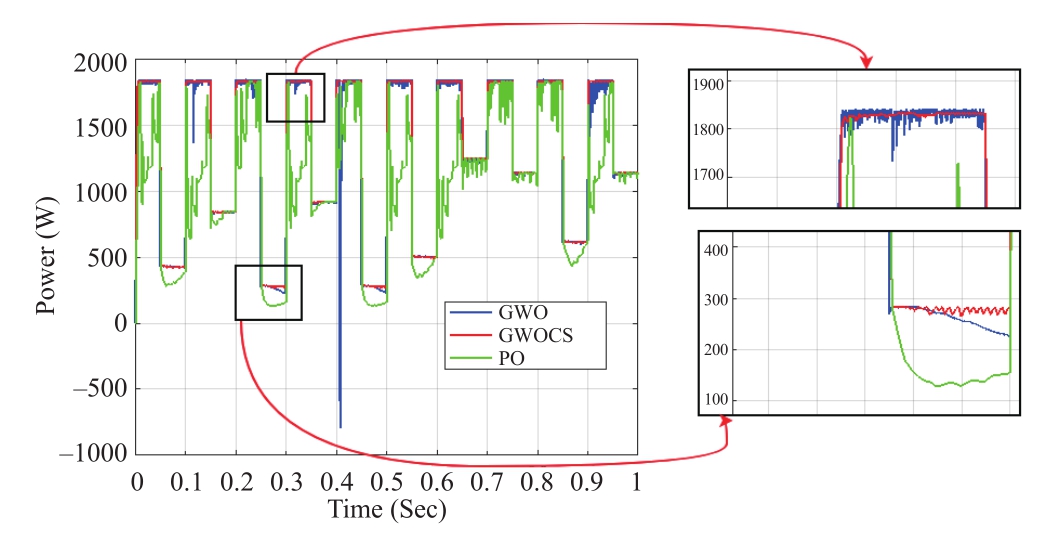
Fig.18 PV power of proposed system under non-uniform irradiance
Finally, the P-V curve is illustrated in Fig.19 to demonstrate that the GWOCS attains maximum power tracking without oscillation and with a higher steady state.It is evident from this figure that the GWOCS attains the maximum point without swinging about the maximum point, compared with the conventional P&O and GWO MPPT strategies.
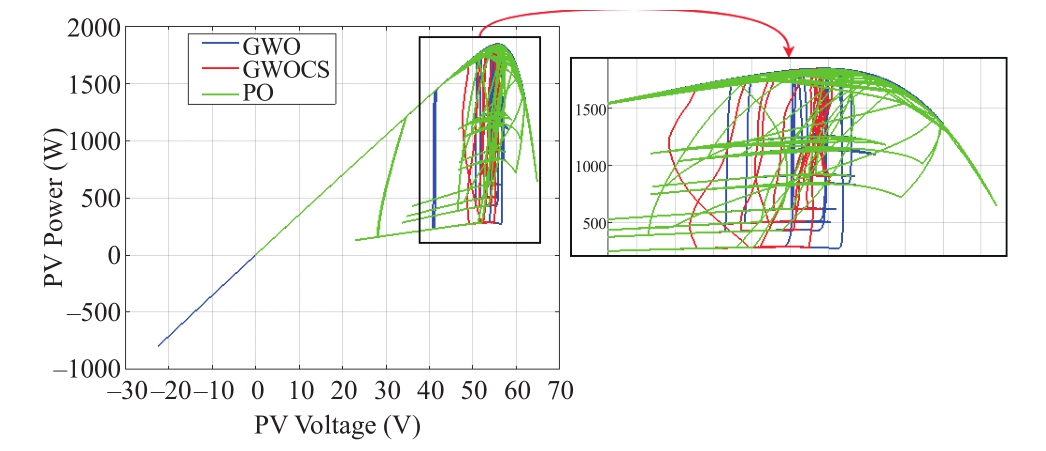
Fig.19 P-V curve at different irradiance levels
6.4 Temperature Variation
The third scenario is designed to show the behavior of the three MPPT approaches to follow the MPP at different temperature values and for constant solar irradiance.Figure 20 depicts the profile utilized for this test scenario.It should be emphasized that this fluctuation occurs between medium temperature levels, 37.5 ℃, 60 ℃, and 75 ℃.Irradiation is also maintained constant during these temperature variations, as observed at STC (1000 W/m2).Figure 21 shows the MPPT responses received.Compared with irradiation fluctuations, temperature variations do not generate significant variations in performance.However, the performances at three locations are examined in-depth and shown here.As shown in Fig.22-24, the proposed hybrid GWOCS controller has less undershoot than the GWO-based MPPT controllers.The comparative performance of controllers for the maximum power is shown in Fig.22.As can be observed, the performance gains are less drastic than the irradiation day profile.It is evident from this figure that the proposed MPPT based on GWOCS still provides a minimum of energy loss and minimal ripple.This verifies the advantage of the hybrid GWO with CS-based MPPT controllers for achieving MPPT during daytime heat conditions.
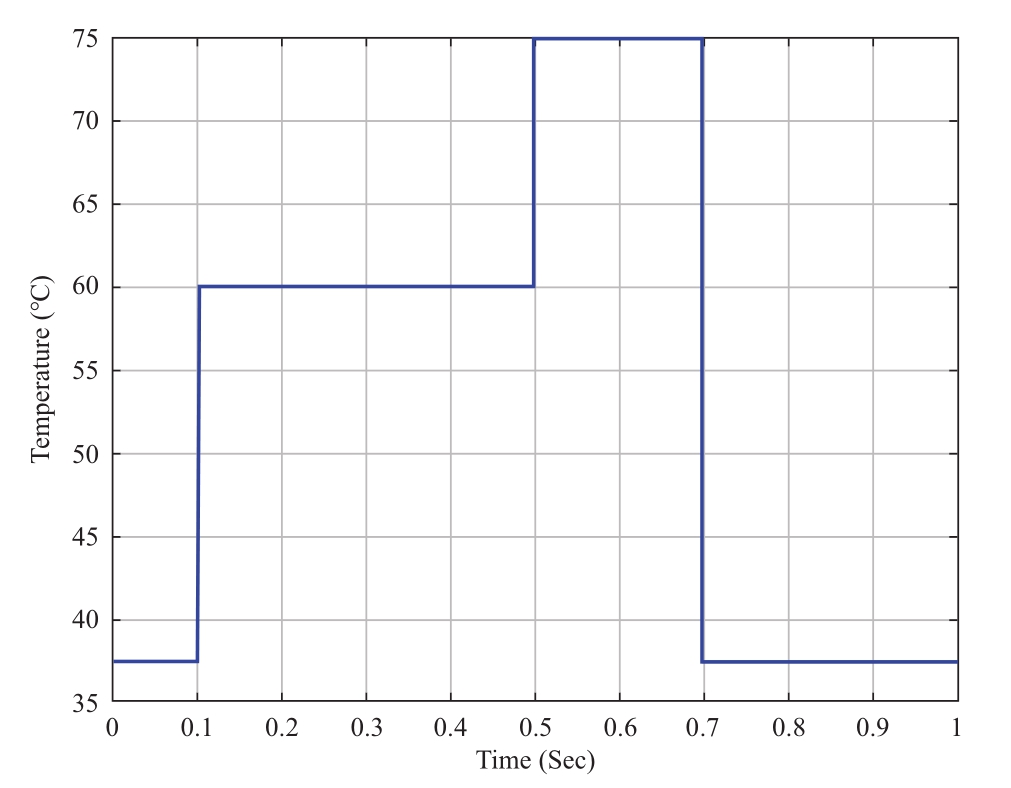
Fig.20 Change profile of temperature
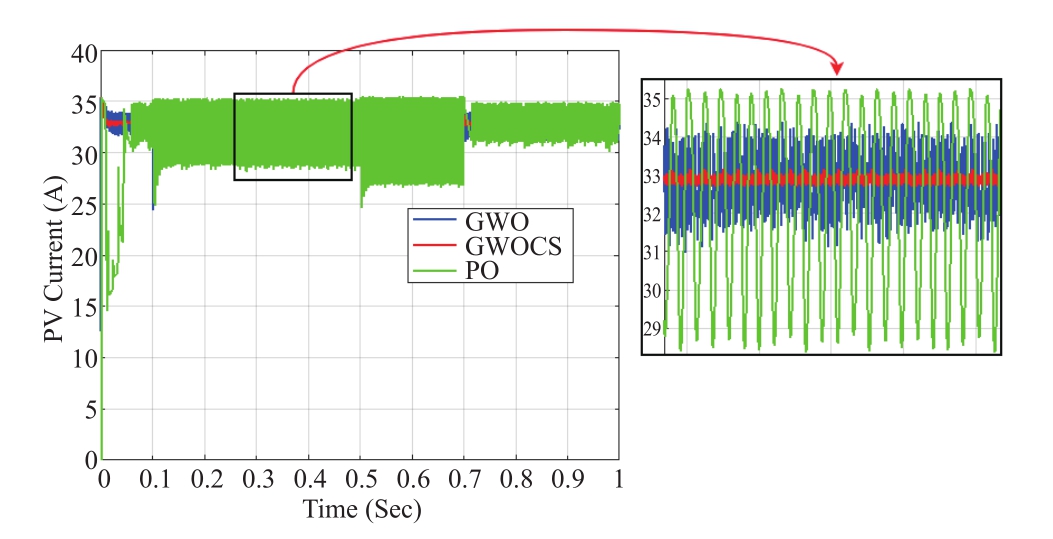
Fig.21 Dynamic response of PV current under variable temperature
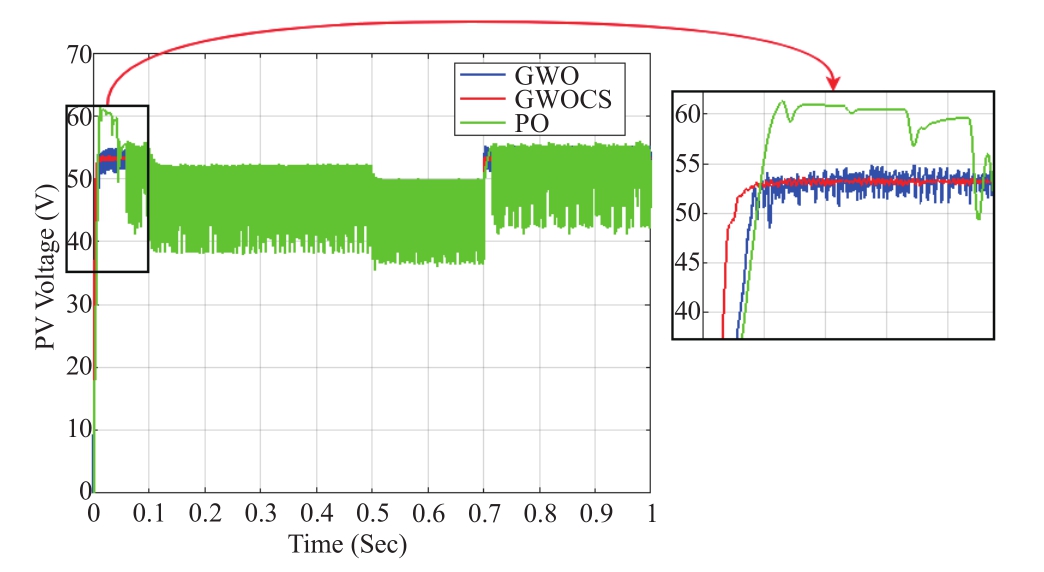
Fig.22 Dynamic response of PV voltage under variable temperature
Figures 23 and 24 show the MPPT responses obtained in terms of PV array power and P-V curve.Compared with irradiation variations, temperature variations do not generate drastic variations in performance.
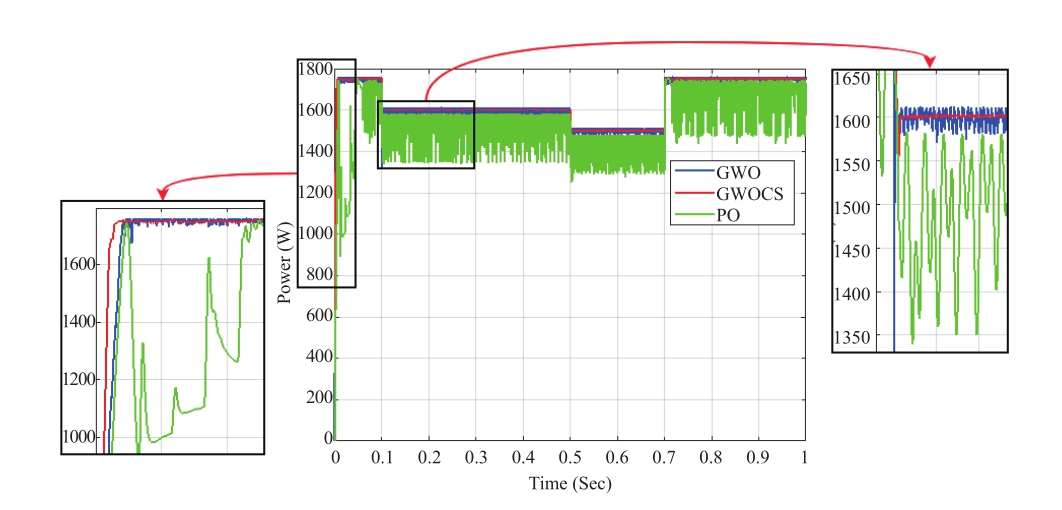
Fig.23 Dynamic response of PV power under variable temperature
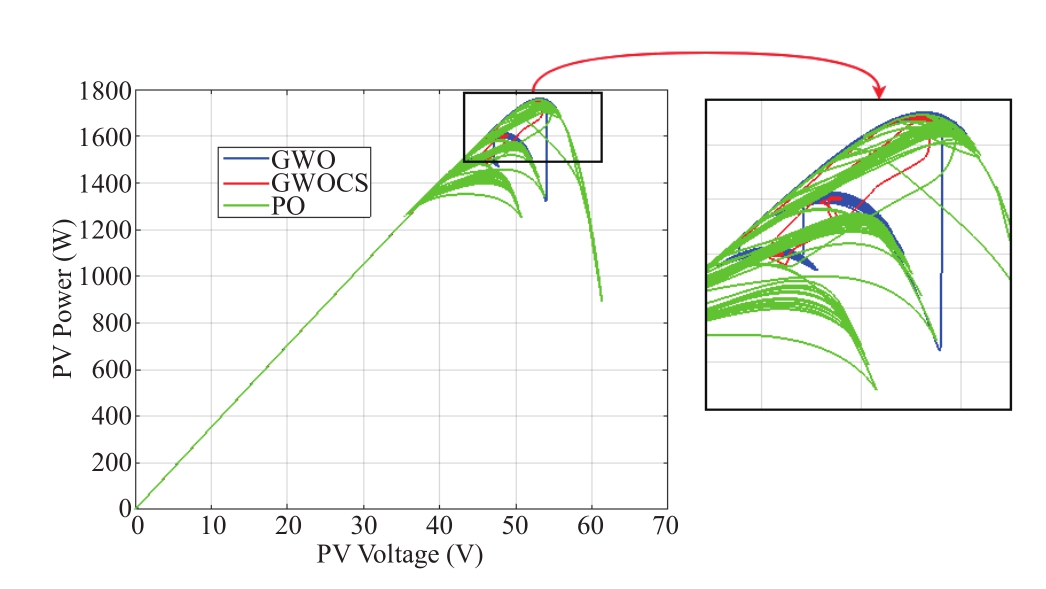
Fig.24 P-V curve under at different temperature levels
6.5 Simultaneous temperature and irradiation variations
The fourth scenario depicts the performance measure of the approaches under a more complex operating condition,wherein both temperature and solar irradiance vary, each with a different profile.This is to demonstrate how the three approaches would behave to follow the MPPs effectively.A critical characteristic test is a mixture of irradiance and temperature variations.The profile utilized is shown in Fig.25 and 26.As shown in these figures, it includes both sharp and smooth fluctuations in irradiation and temperature.It generates a chaotic and abrupt profile that the PV system may be compelled to function under.
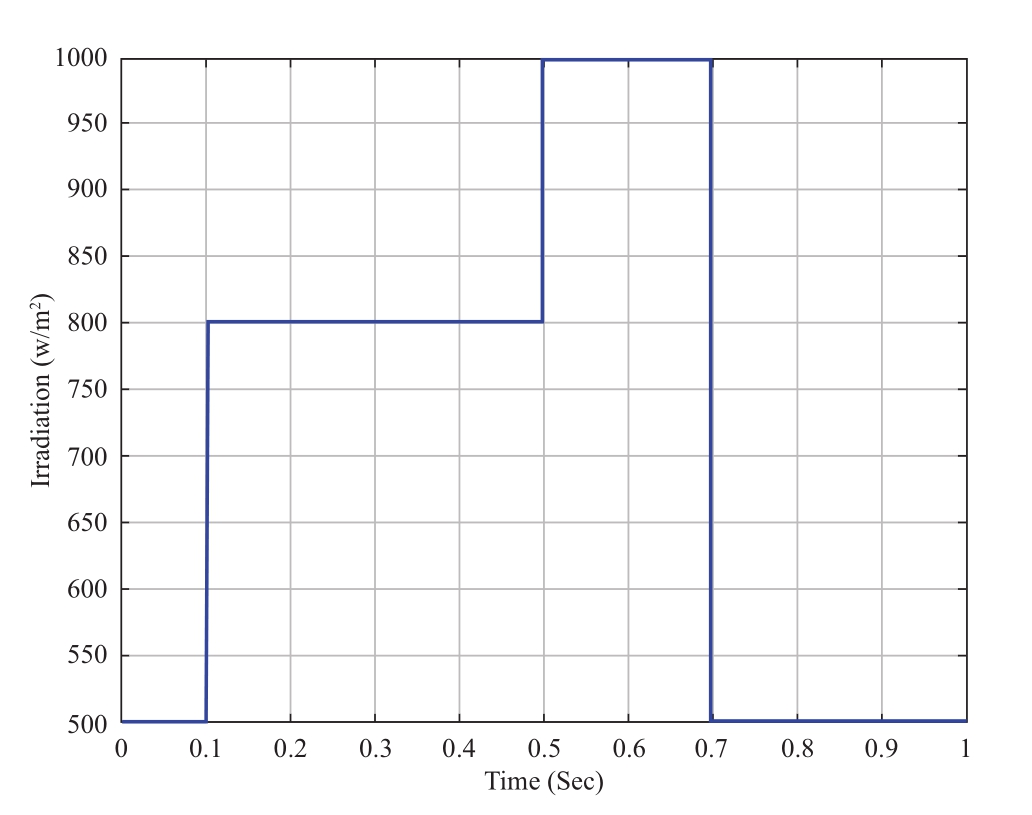
Fig.25 Profile of irradiance
Figures 27-29 illustrate the MPPT responses for combined temperature and irradiation variations.Figures 27 and 28 show that compared with other MPPT controllers,the MPPT-based hybrid GWOCS controller displays the least degree of undershoot and the fastest tracking oftemperature and irradiance variations that occur randomly.Meanwhile, GWOCS-based MPPT recovers faster than GWO-based MPPT does.
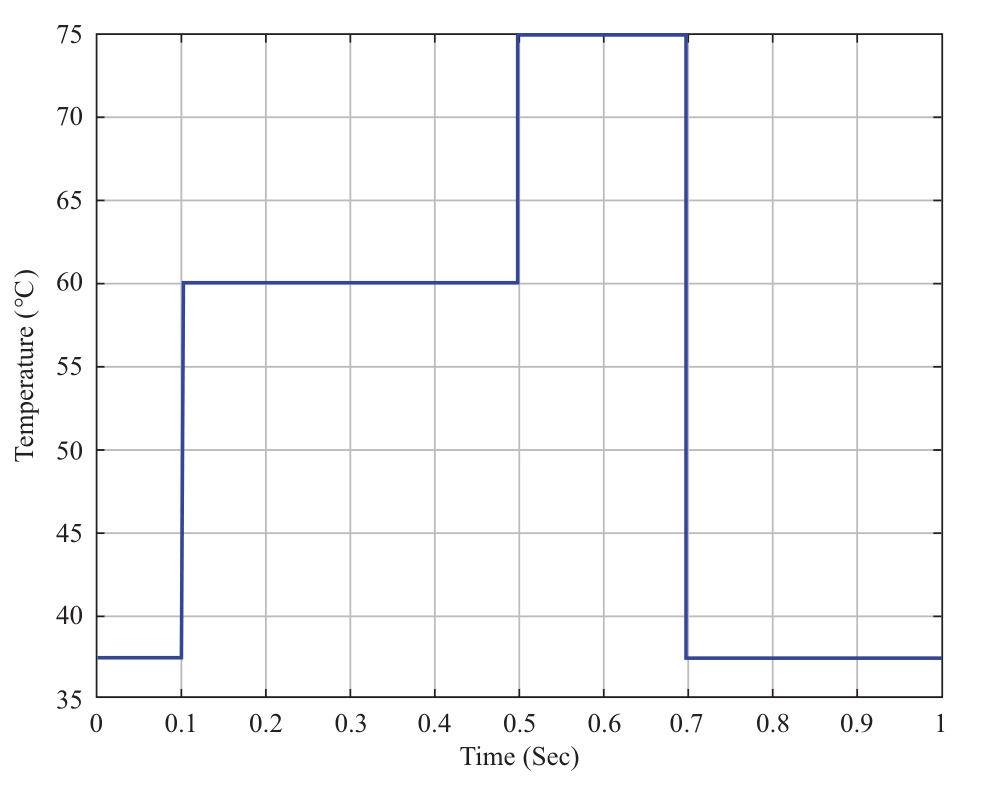
Fig.26 Profile of variable temperature
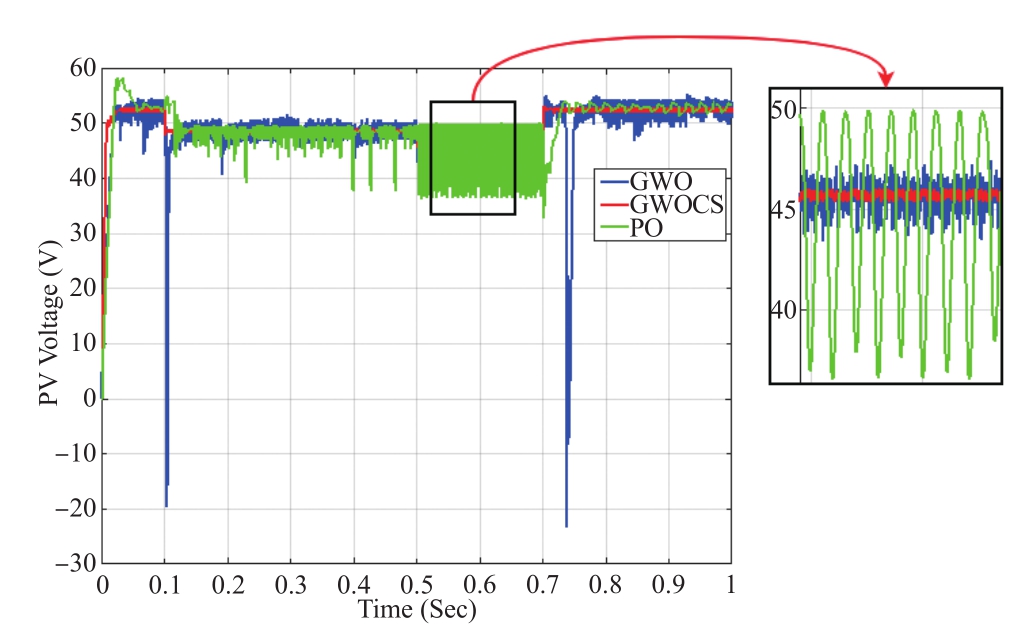
Fig.28 PV voltages dynamic response under varying temperatures and irradiance
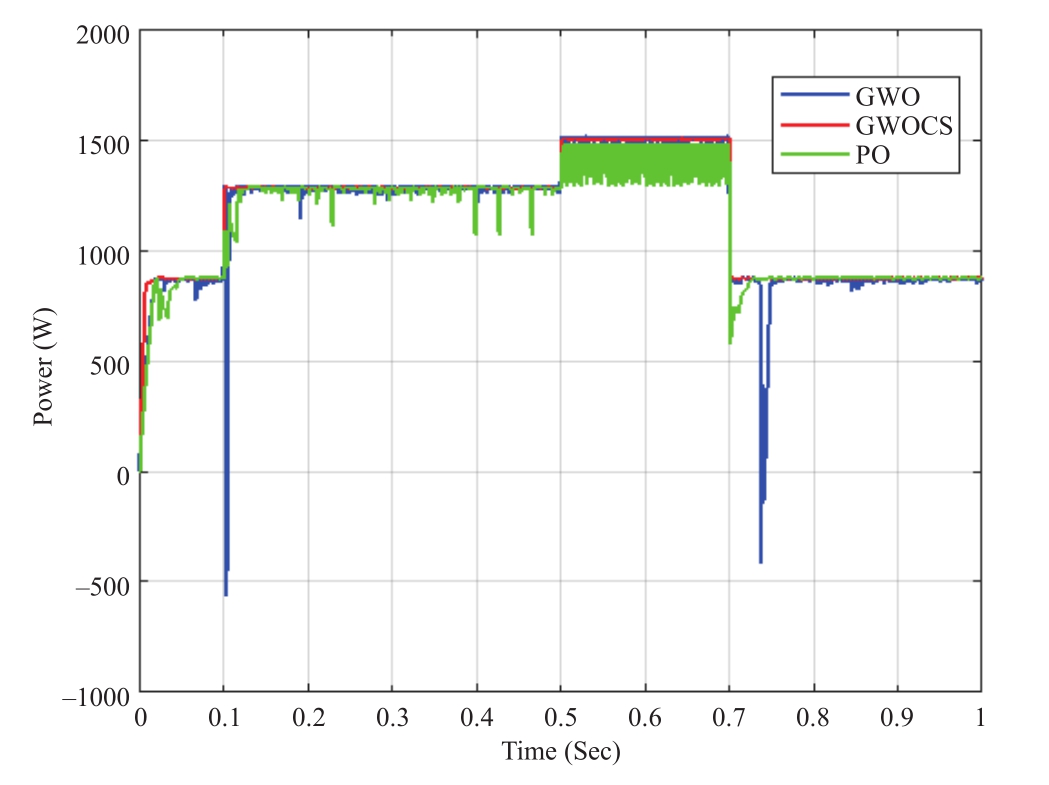
Fig.29 Dynamic response of PV power under variable temperature and irradiance
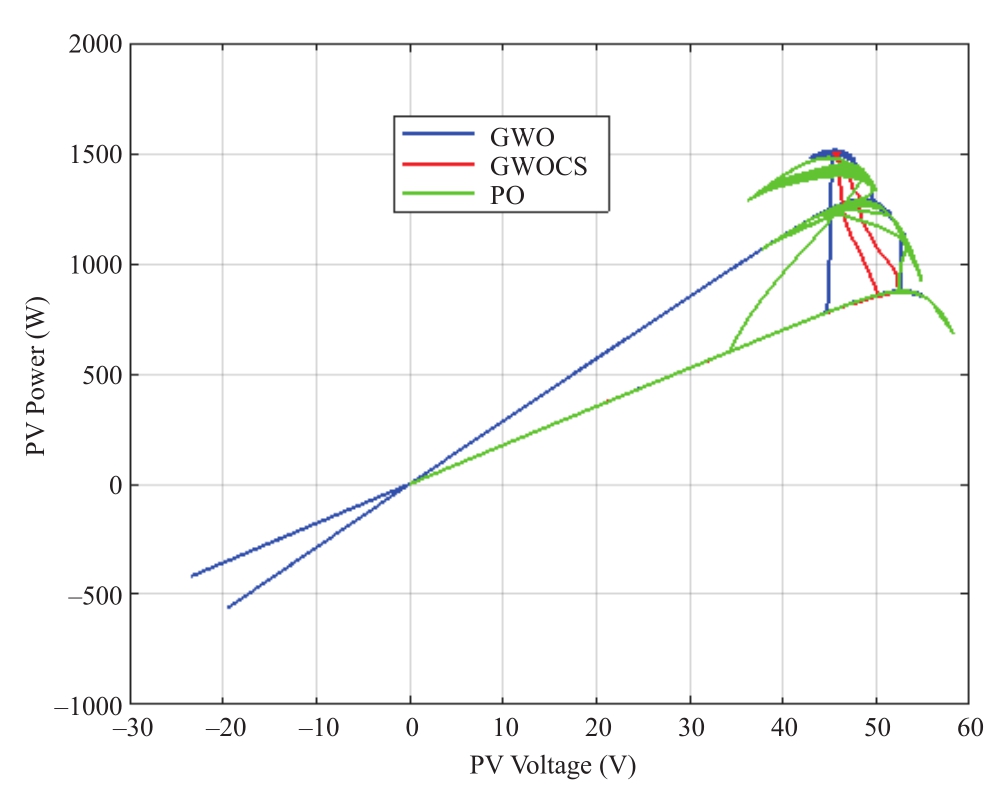
Fig.30 P-V curve under varying irradiance and temperatures levels
The GWO MPPT stops tracking direction when both the controllers approach the point where the power to the left and right of the point are nonlinear in relation.This causes significant undershoot at 0.3 s and 0.7 s.However,the GWOCS-based MPPT controller continues to track the intended power with no variation.As indicated earlier,GWOCS-based MPPT controllers can recover more rapidly from variations in direction in tracking intended power.Because other controllers still generate significant oscillatory activity after achieving MPPT, the hybrid optimizer controller has the smallest settling time.It is apparent that compared with the other MPPT, the GWOCS-based MPPT controller generates the least ripple for steadystate conditions as indicated in the magnified sections in Fig.27-30.Note that the GWOCS-based MPPT response in this situation either perfectly overlaps the GWO-based MPPT response or has a better response than the other MPPT.

Fig.27 Dynamic response of PV currents under varying temperature and irradiance
continue
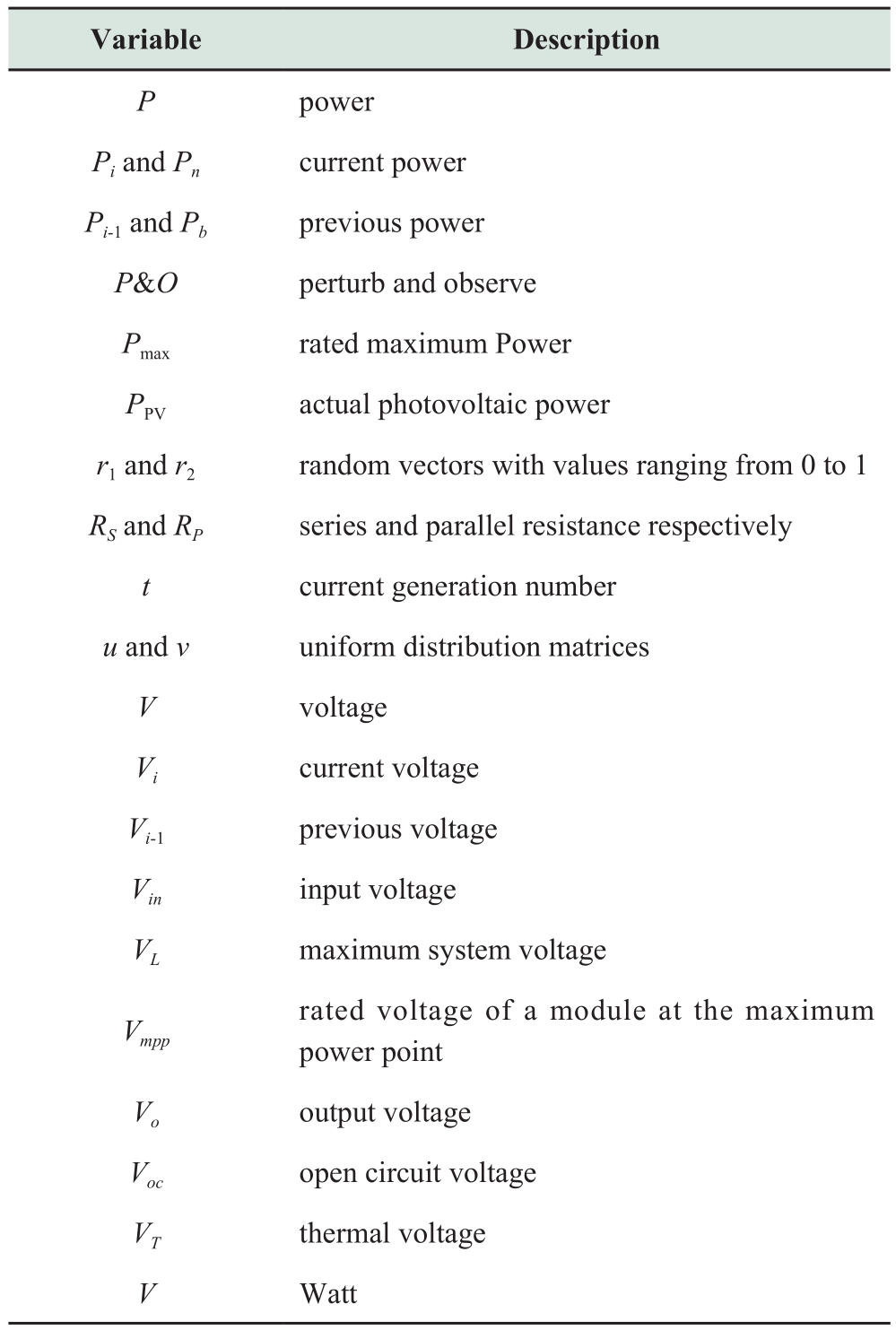
continue

6.6 Irradiation Sinusoidal test
The fifth and final scenario shows the performance of the three MPPT approaches to address continuously varying solar irradiance with small and smooth variation values at a constant temperature.This case would show the strength of the approaches in following the continuously varying MPP in a short time.This is important for testing the performance under a rapidly varying environment.The baseline irradiation profile for this case is shown in Fig.31.Because large irradiance fluctuations would result from relatively transitory variations in the environment, the variation occurs within an irradiation band of 200–1000 nm.Furthermore,the temperature is maintained constant at STC (25 °C)during these irradiation variations.
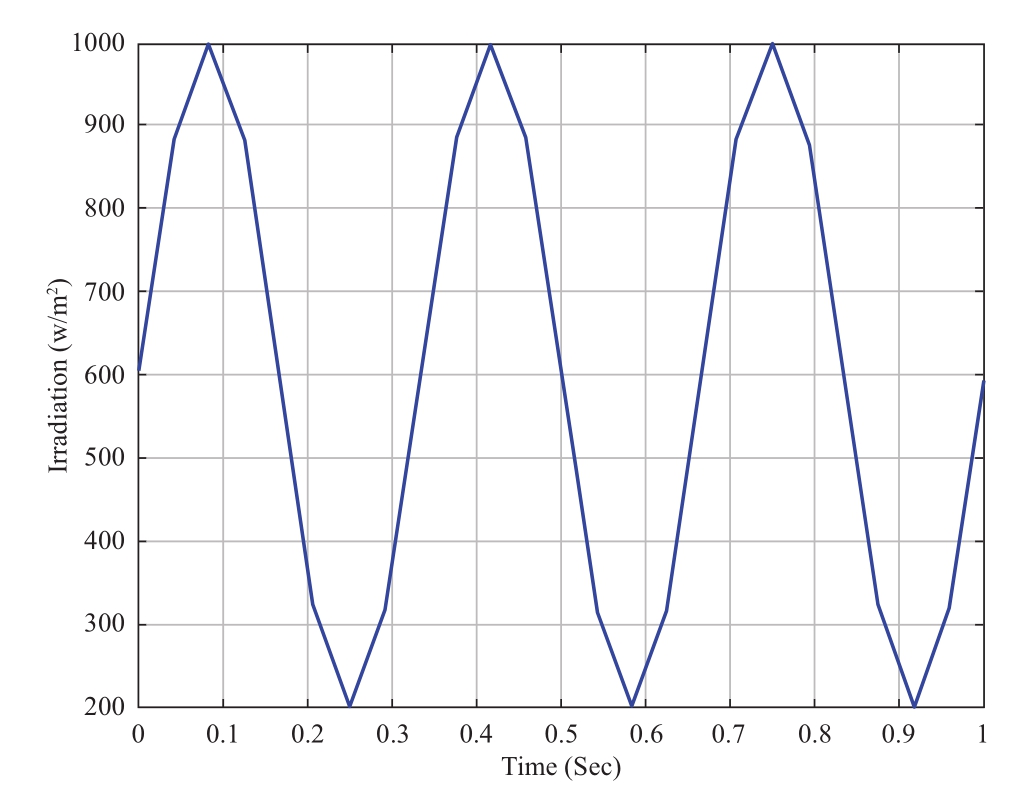
Fig.31 Sinusoidal profile of irradiance
As stated earlier, most conventional and intelligent MPPT controllers fail to track success in these situations.Meanwhile, the conventional P&O algorithm cannot follow the desired power according to the input irradiance (see Fig.32).Meanwhile, the proposed MPPT controller keeps track of the system’s response and prevents it from deviating from the set point.Hence, a hybrid intelligent algorithm is required to solve this problem.In the exact figure, the proposed hybrid MPPT is a seamless transition from a higher power to a lower power without ripple, overshoot,or oscillation.As observed, there is no abrupt variation in power because irradiance varies continuously and smoothly(rather than in insignificant steps) as examined in the three previous tests.
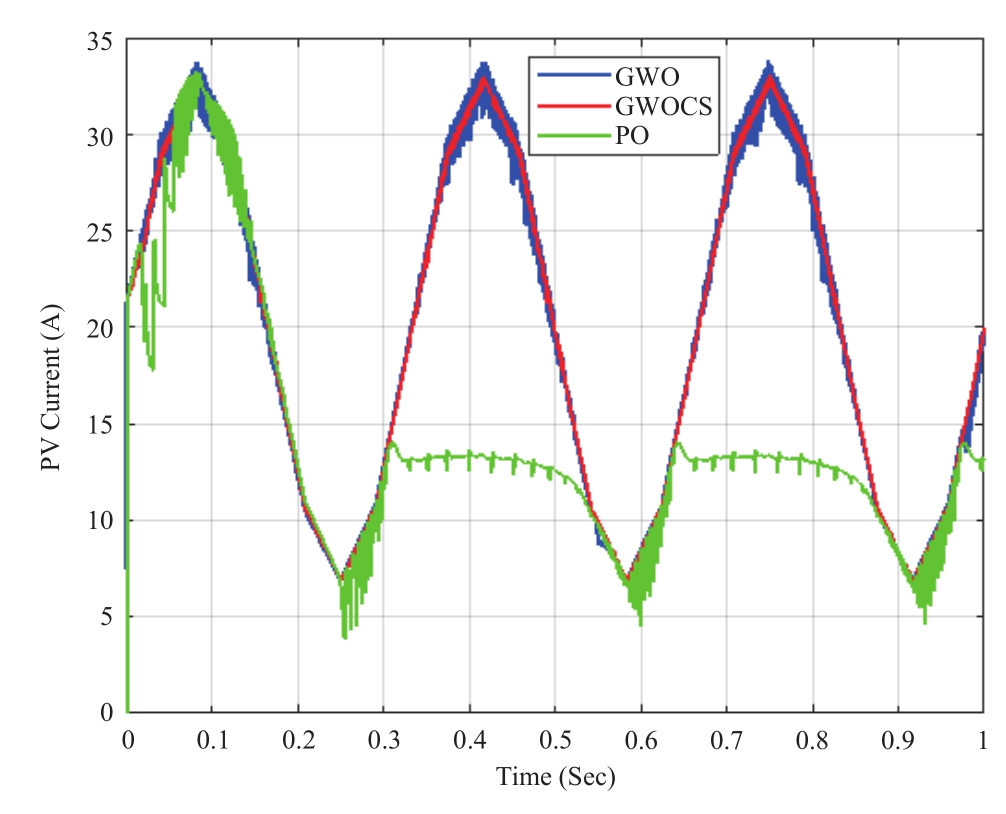
Fig.32 Dynamic response of PV current under sinusoidal test
Figure 32 shows the response PV array current.It is evident from this figure that the GWOCS tracks the desired current according to the available insolation notwithstanding the critical variation irradiation as a sinusoidal waveform.Meanwhile, the PV array voltage response is shown in Fig.32.It is evident from the figure that the voltage response is constant owing to the physics behavior of the PV system.
Finally, the P-V curve of the sinusoidal test is depicted in Fig.34.It can be observed from this figure and Fig.33 that compared with existing MPPTs, the proposed GWOCS MPPT achieves the least amount of ripple.Note that the power variations occur more rapidly at zoomed portions,which denote the rise and fall, respectively, than the GWO and P&O algorithms, which denote the response is a practically steady-state with slight variations.Thus, GWO is superior to the other MPPTs because it can adapt to such a dynamic environment and provides the smallest deviation from its planned power locus.
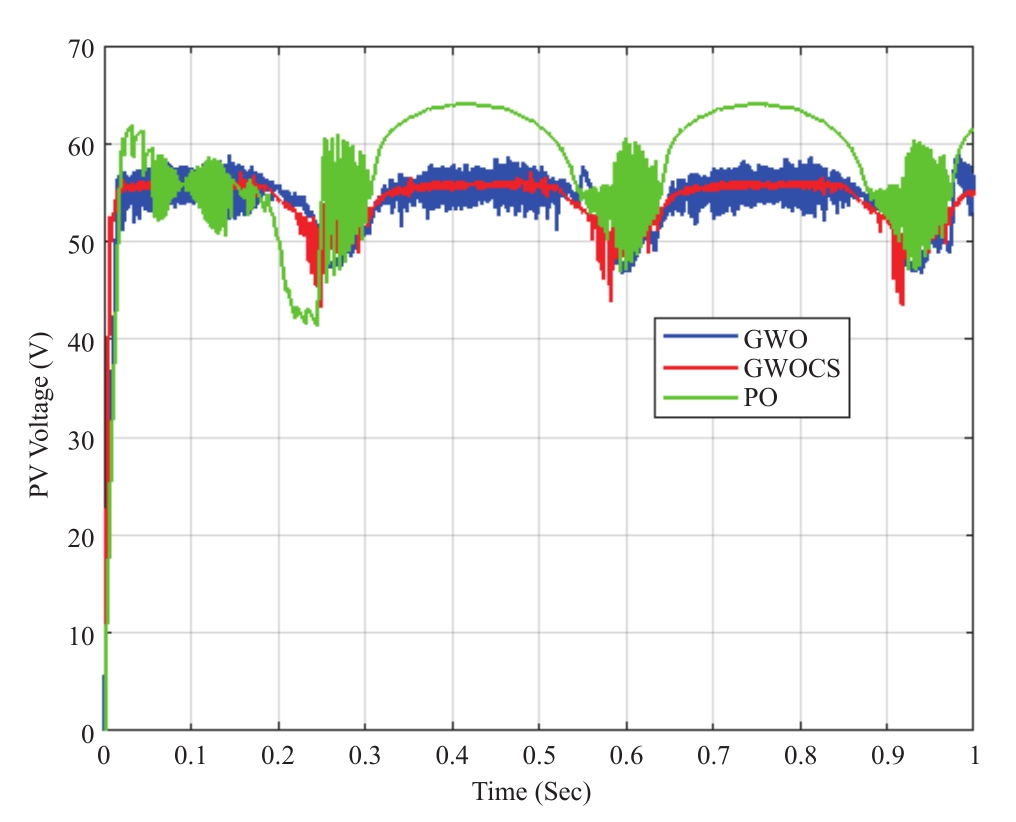
Fig.33 Dynamic response of PV voltage under sinusoidal test

Fig.34 Dynamic response of PV power under sinusoidal test

Fig.35 P-V curve under sinusoidal test
7 Comparison of performance among MPPT strategies
Specific additional tests are examined.These use various indices to describe how the recommended and compared algorithms behave under static and dynamic variations.The following are the indices:
Accuracy αMPPT: This index is used to determine how nearly the tracking is to attain its maximum point.It is utilized in our study to show how close the PV current is to the current MPP during tracking, as shown below:
Index of static efficiency ηMPPT: The MPPT graph depicts the ratio of actual PV power to maximum PV power.It is provided by
Relative tracking error∈ MPPT : It is expressed as follows:
In addition, the efficiency and energizing error of the MPPT are reflected by the indices in (32) and (33).These are utilized to compare the tracking performance of the proposed and standard approaches under dynamic variations in the MPP.
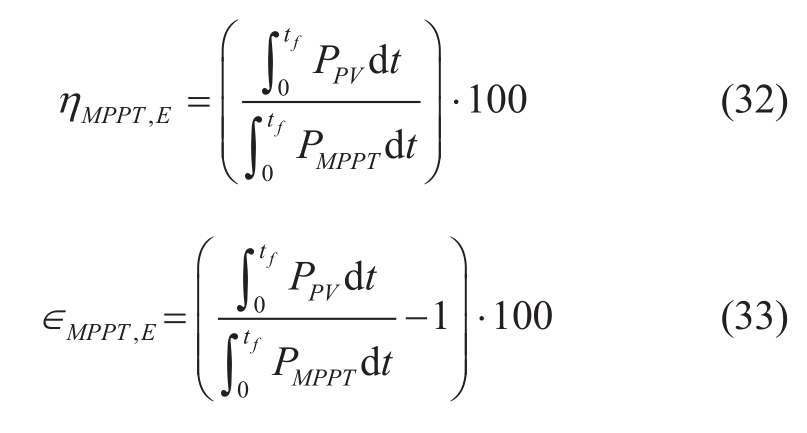
The proposed GWOCS algorithm has a higher tracking speed and provides superior performances in terms of efficiency and power quality than the conventional ones.This can be observed from the prior observations.The values of the considered indices for the proposed and standard MPPT algorithms under STC conditions for the power response indicated in Fig.13 are shown in Tables 3 and 4.The performance of the proposed GWOCS-based MPPT algorithm for the power response is demonstrated to be superior to the GWO-based MPPT and conventional P&O.It can be observed from these tables that the results of GWO are better than those of the P&O algorithm.
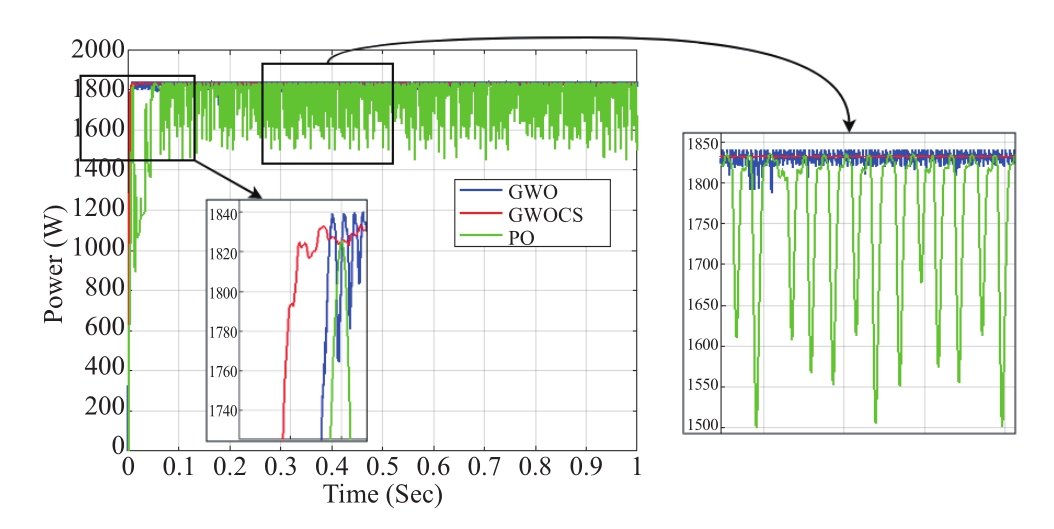
Fig.13 PV power response under STC condition
Table 3 Performance comparison of proposed and conventional P&O algorithms
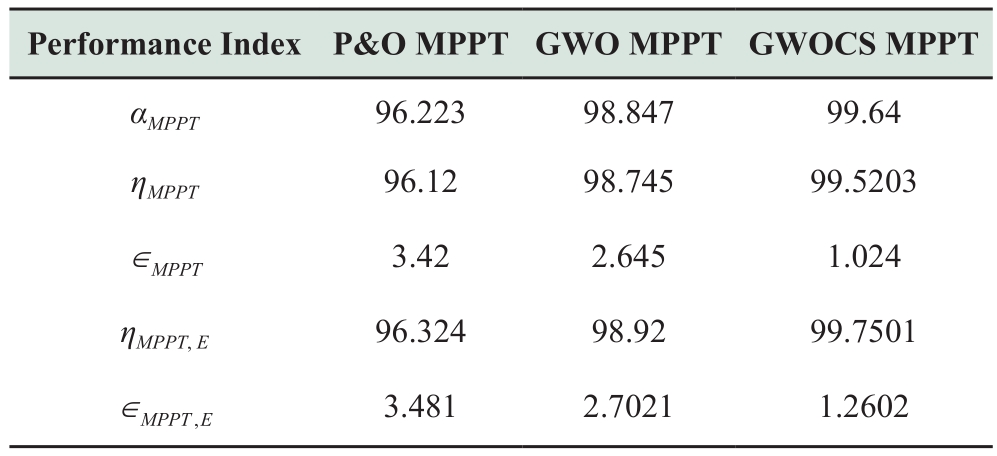
Table 4 Specification Performances under STC conditions
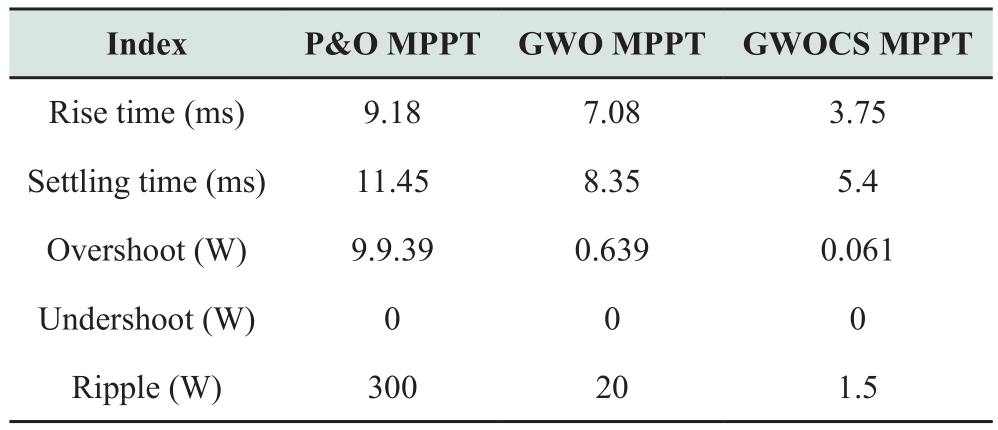
The performance values are presented in Tables 5 and 6,respectively.These tables highlight the performance parameters for the combined profile.GWOCS-based MPPT yields better performance in all areas of the system responses in this situation—the most significant and most negligible reductions in energy loss.As shown in Table 5,the comparisons show that the GWOCS-based MPPT is superior even in highly unpredictable and dynamic contexts.
Table 5 Performance comparison between proposed and conventional P&O algorithms under combined profile

Table 6 Specification performances under combined profile
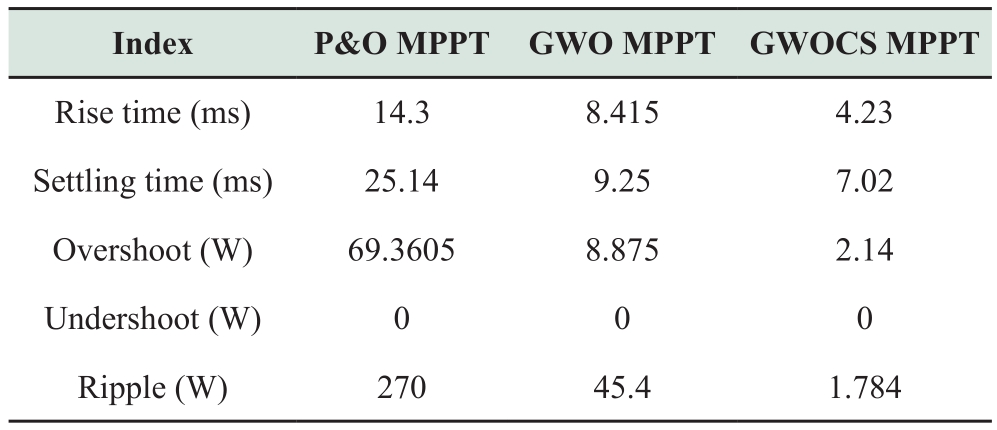
8 Conclusion
The photovoltaic energy efficien cy, stability, and reliability are important aspects in promoting this energy resource in the market.To maximize the output power of a PV array, the standard MPPT techniques such as P&O, GWO, and hybrid GWO with CS (GWOCS) were developed in this research for the PV system.The objective was also to improve the stability and reliability of PV power conversion, particularly under an abrupt shift in meteorological circumstances.Therefore, the super lift Luo converter was used rather than a conventional boost converter.
To assess the performance of the various MPPT controllers, MATLAB SIMULINK was used to construct the PV system modeling and control.The key observations reveal that the use of an MPPT controller with a PV system increases the output PV power, decreases the convergence time, and reduces the MPP fluctuations.Consequently, the PV system’s average tracking efficiency and the stability and reliability of PV generation improved when it connects to the DC load.
Although there are various algorithms for MPPT, the P&O algorithm is extensively utilized owing to its low cost and convenience of implementation.However, this method has a long convergence time, considerable oscillation around the MPP, and the drift problem associated with rapidly varying irradiance as its principal limitations.Meanwhile,PV systems based on conventional and modified P&O algorithms produce fluctuating DC voltage during rapidly varying weather conditions.These do not eliminate the drift problem and oscillation around the MPP.The modified P&O-MPPT based on the GWO algorithm was presented to address the primary limitations of the standard P&O algorithm.
The GWO method-based MPPT technique is better for constructing a PV-MPPT controller.This is because it achieves a higher tracking efficiency and faster tracking speed in experimental measurement tests.
GWOCS has a zero-failure rate, a convergence time less than 0.02 s, and zero oscillations around the steady-state conditions.
The recommended MPPT methodology based on the GWOCS and P&O algorithm is preferable for enhancing PV electrical generation owing to its capacity to track the MPP when large irradiation fluctuations occur.Meanwhile,the modified P&O-MPPT approach was developed for inexpensive PV systems.Thereby, it passed the EN50530 standard test with the highest tracking efficiency.
Finally, the simulation results demonstrated that the GWOCS is effective for various circumstances and critical disturbances in fast-tracking and significantly small oscillation.Thereby, according to the EN50530 standard test, the GWO approach achieved average tracking efficiencies of approximately 98.847%, whereas the recommended hybrid GWOCS control technique stands out for robustness and steady-state power tracking heading to attain a maximum efficiency of 99.5301%.However,the current limitation of the proposed approach is that it is computationally expensive and difficult to implement compared with the conventional P&O approach.
Other issues need to be addressed if investment in this energy resource becomes more appealing, with the following ideas.It would be advantageous to enhance the PV system's performance while being partially shaded.This problem occurs when a portion of the PV array is shaded because of a tree shadow or dust.The PV array would generate various MPPs in this instance.Thereby, the installed PV array's total generating efficiency reduces.An MPPT controller based on the hybrid deep neural network and GWOCS algorithm could solve this problem.In addition, the proposed system would be implemented as a hardware prototype to account for challenges presented in realistic scenarios.
Declaration of Competing Interest
We declare that we have no conflict of interest.
Appendix A – Nomenclature of variables used in this paper
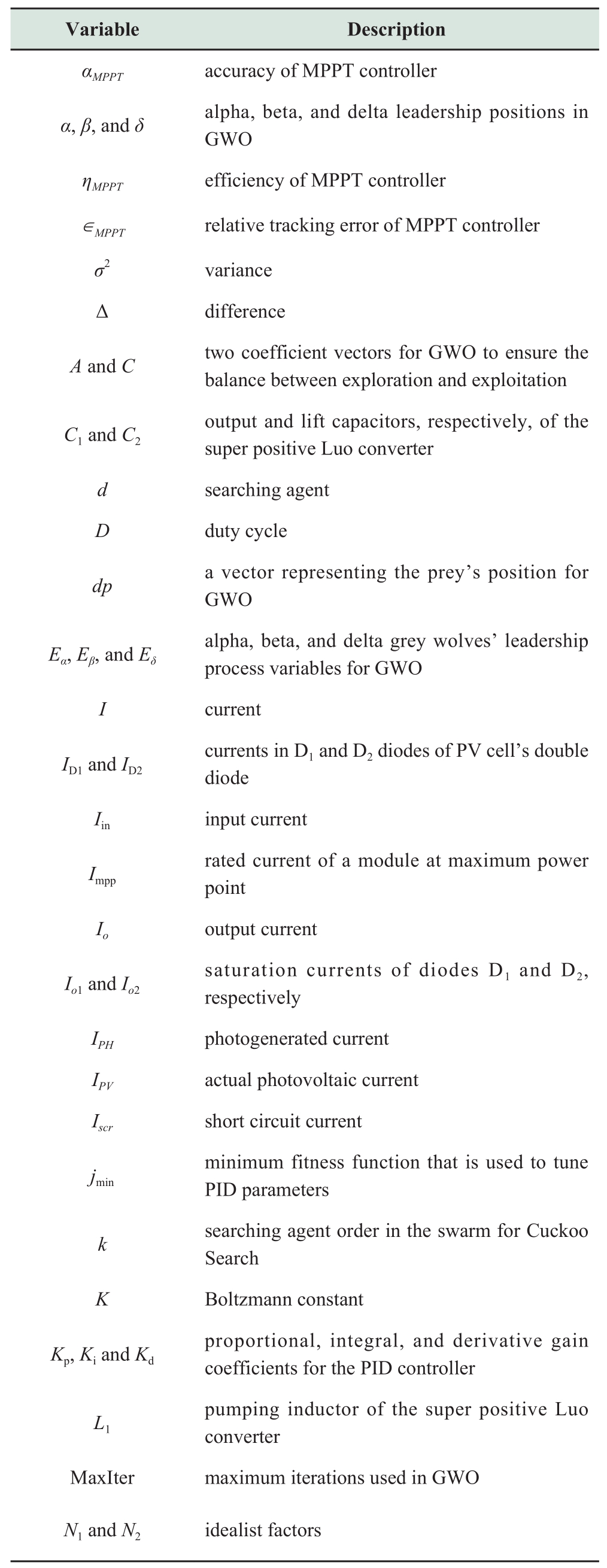
References
[1]Kamarulzaman A, Hasanuzzaman M, Rahim N A (2021)Global advancement of solar drying technologies and its future prospects: A review.Solar Energy, 221: 559-582
[2]Kamarzaman N A, Tan C W (2014) A comprehensive review of maximum power point tracking algorithms for photovoltaic systems.Renewable and Sustainable Energy Reviews, 37: 585-598
[3]Ali A, Almutairi K, Padmanaban S, et al.(2020) Investigation of MPPT techniques under uniform and non-uniform solar irradiation condition–a retrospection.IEEE Access, 8: 127368-127392
[4]Sarvi M, Azadian A (2022) A comprehensive review and classified comparison of MPPT algorithms in PV systems.Energy Systems, 13: 281-320
[5]Kler D, Rana K P S, Kumar V (2018) A nonlinear PID controller based novel maximum power point tracker for PV systems.Journal of the Franklin Institute, 355(16): 7827-7864
[6]Nadeem, A, Hussain A (2021) A comprehensive review of global maximum power point tracking algorithms for photovoltaic systems.Energy Systems, doi: 10.1007/s12667-021-00476-2
[7]Aldosary A, Ali Z M, Alhaider M M, et al.(2021) A modifiedshuffled frog algorithm to improve MPPT controller in PV System with storage batteries under variable atmospheric conditions.Control Engineering Practice, 112: 104831
[8]Fraunhofer I, Current and future cost of photovoltaics.Long-term scenarios for market development, System prices and LCOE of utility-scale PV systems.Study on behalf of Agora Energiewende.Fraunhofer-Institute for Solar Energy Systems (ISE) https://www.ise.fraunhofer.de/content/dam/ise/de/documents/publications/studies/AgoraEnergiewende_Current_and_Future_Cost_of_PV_Feb2015_web.pdf.2015
[9]Green M A, Hishikawa Y, Warta W, et al.(2017) Solar cell efficiency tables (version 50).Progress in Photovoltaics: Research and Applications, 25(7): 668-676
[10]Xu L, Cheng R, Yang J, et al.(2020) A new MPPT technique for fast and efficient tracking under fast varying solar irradiation and load resistance.International Journal of Photoenergy, 2020:6535372
[11]Eltamaly A M (2021) A novel musical chairs algorithm applied for MPPT of PV systems.Renewable and Sustainable Energy Reviews, 146: 111135
[12]Guo K, Cui L, Mao M, et al.(2020) An improved Gray Wolf Optimizer MPPT algorithm for PV system with BFBIC converter under partial shading.IEEE Access, 8: 103476-103490
[13]Rezk H, Aly M, Fathy A (2021) A novel strategy based on recent equilibrium optimizer to enhance the performance of PEM fuel cell system through optimized fuzzy logic MPPT.Energy, 234:121267
[14]Rezk H, Al-Oran M, Gomaa R, et al.(2019) A novel statistical performance evaluation of most modern optimization-based global MPPT techniques for partially shaded PV system.Renewable and Sustainable Energy Reviews, 115: 109372
[15]Mamun, M A A, Hasanuzzaman M, Selvaraj J (2017)Experimental investigation of the effect of partial shading on photovoltaic performance.IET Renewable Power Generation,11(7): 912-921
[16]Eltamaly A M (2021) An improved Cuckoo Search algorithm for maximum power point tracking of photovoltaic systems under partial shading conditions.Energies, 14(4): 953
[17]Yang B, Zhu T, Wang J, et al.(2020) Comprehensive overview of maximum power point tracking algorithms of PV systems under partial shading condition.Journal of Cleaner Production,268: 121983
[18]Messalti S, Harrag A, Loukriz A (2017) A new variable step size neural networks MPPT controller: Review, simulation and hardware implementation.Renewable and Sustainable Energy Reviews, 68: 221-233
[19]Soufi Y, Bechouat M, Kahla S (2017) Fuzzy-PSO controller design for maximum power point tracking in photovoltaic system.International Journal of Hydrogen Energy, 42(13): 8680-8688
[20]Subiyanto S, Mohamed A, Hannan M A (2012) Intelligent maximum power point tracking for PV system using Hopfield neural network optimized fuzzy logic controller.Energy and Buildings, 51: 29-38
[21]Kaced K, Larbes C, Ramzan N, et al.(2017) Bat algorithm based maximum power point tracking for photovoltaic system under partial shading conditions.Solar Energy, 158: 490-503
[22]Mohanty S, Subudhi B, Ray P K (2016) A new MPPT design using Grey Wolf Optimization technique for photovoltaic system under partial shading conditions.IEEE Transactions on Sustainable Energy, 7(1): 181-188
[23]Sharma S, Kapoor R, Dhiman S (2021) A novel hybrid Metaheuristic based on augmented Grey Wolf Optimizer and Cuckoo Search for global optimization.Proceedings of 2021 2nd International Conference on Secure Cyber Computing and Communications
[24]Khan N M, Khan U A, Zafar M H (2021) Maximum power point tracking of PV system under uniform irradiance and partial shading conditions using machine learning algorithm trained by Sailfish Optimizer.Proceedings of 2021 4th International Conference on Energy Conservation and Efficiency
[25]Yang B, Zhong L, Zhang X, et al.(2019) Novel bio-inspired memetic salp swarm algorithm and application to MPPT for PV systems considering partial shading condition.Journal of Cleaner Production, 215: 1203-1222
[26]Yang B, Yu T, Zhang X, et al.(2019) Dynamic leader based collective intelligence for maximum power point tracking of PV systems affected by partial shading condition.Energy Conversion and Management, 179: 286-303
[27]BlueStorm, Solar Panel-Blue Storm, https://blue-storm.ca/home/193-solar-panel.html Accessed 6 October 2021
[28]Bana S, Saini R P (2016) A mathematical modeling framework to evaluate the performance of single diode and double diode based SPV systems.Energy Reports, 2: 171-187
[29]El-Ghanam S M (2020) Design, implementation and performance analysis of positive super-lift Luo-converter based on different MOSFET types.Indian Journal of Physics, 94(6): 833-839
[30]Ss D, Balasubramanian M S, Krishnaveni L (2020) Performance improvement of photo-voltaic panels by Super-Lift Luo converter in standalone application.Materials Today: Proceedings, 37(2):1163-1171
[31]Luo F, Ye H (2003) Positive output super-lift converters.IEEE Transactions on Power Electronics, 18(1): 105-113
[32]Fan Y, Shao J, Sun G (2019) Optimized PID controller based on Beetle Antennae Search algorithm for electro-hydraulic position servo control system.Sensors, 19(12): 2727
[33]Yang X, Deb S (2010) Cuckoo Search via Lévy flights.Proceedings of 2009 World Congress on Nature & Biologically Inspired Computing
[34]Mirjalili S, Mirjalili S, Lewis A (2014) Grey Wolf Optimizer.Advances in Engineering Software, 69: 46-61
[35]Long W, Cai S, Jiao J, et al.(2020) A new hybrid algorithm based on grey wolf optimizer and Cuckoo Search for parameter extraction of solar photovoltaic models.Energy Conversion and Management, 203: 112243
Received: 13 April 2022/ Accepted: 28 July 2022/ Published: 25 December 2022
M.Hasanuzzaman
hasan@um.edu.my
Jinan Abdulhasan Salim
jenanabdulhasan@gmail.com
Baraa M.Albaker
baraamalbaker@ymail.com
Muwafaq Shyaa Alwan
abulaithmsh@yahoo.com
Biographies

Jinan Abdulhasan Salim is working toward the M.Sc.degree at the College of Engineering,Al-Iraqia University, Baghdad, Iraq.Her research interests include artificial intelligence and renewable energy.

Asst.Prof.Dr.Baraa Munqith Albaker received the Ph.D.degree at University of Malaya, Malaysia, 2012.Presently, he works as the head of the Electrical Engineering department at Al-Iraqia University, Baghdad, Iraq.His research interests include contemporary development in computer and control applications.
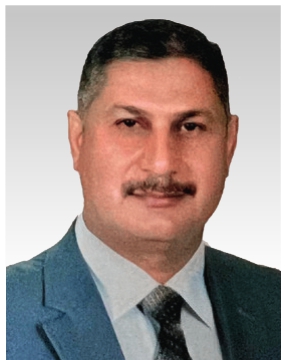
Prof.Dr.Muwafaq Sh.Alwan received the Ph.D.degree at University of Technology,Baghdad, Iraq in 2012.He is working as lecturer and researcher at the College of Engineering, Al-Iraqia University, Baghdad,Iraq.His research interests include thermal performance of film cooling and renewable energy.

Md.Hasanuzzaman received the B.Sc.degree in Mechanical Engineering from Bangladesh University of Engineering and Technology (BUET), Bangladesh, in 2005,and the M.Eng.Sc.and Ph.D.degrees from University of Malaya, Malaysia, in 2008 and 2011, respectively.Dr.Hasanuzzaman is presently working as Associate Professor at the UM Power Energy Dedicated Advanced Centre, Higher Institution Centre of Excellence (HICoE), University of Malaya, Malaysia.He was listed among the world’s top 2% scientists for the years 2020 and 2021.He received a University of Malaya Excellence Award in 2012 for his remarkable achievement during his Ph.D.studies,and received the Bangladesh Scholarship Council and the Nippon Foundation (Japan, 2003–2004).
(Editor Yajun Zou)
